Fire Season 2017-18 Overview
Aerial Fire Fighting in Australia
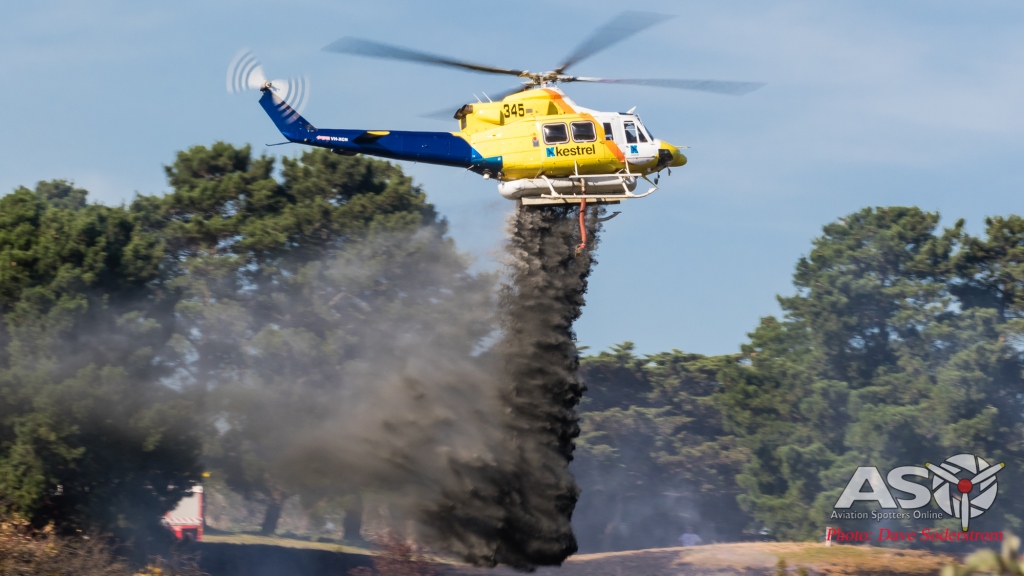
This fire season has again brought out the importance of the fleet of Aerial Fire Fighting appliances. They work alongside the men and women on the ground operating the trucks, bulldozers and importantly the fire hoses. No sooner had the 2017 season ended and the international aircraft and crews departed back to their home operating bases. They were soon back in action fighting fires across North America and Canada. In particular, we watched the TV as the most destructive period on record, which saw multiple wildfires burning across California. A grand total of 9,133 fires burned over 1,381,405 acres, according to the California Department of Forestry and Fire Protection. There is an enormous cost associated with the fires too with some $9.4 billion in insured property that has been damaged or destroyed. Not only is property destroyed but many lives have been lost over the years due to bushfires. In Australia we have seen the huge financial costs and deaths associated with large fires especially in recent times. Some of Australia’s largest and costliest incidents have been Black Saturday in Victoria 2009, Margaret River in 2011, Parkerville 2014, Esperance 2015, Yarloop/Waroona/Harvey 2016 in Western Australia and Canberra in 2003, The NSW/TAS fire season in 2013 was significant where over 500 buildings were damaged or destroyed around the state
As a country, we have grown our fire fighting resources as the urban sprawl continues to expand. The fire services call it the Rural Urban Interface or RUI. State governments have spent huge sums upgrading all aspects of fire fighting equipment. As new technology becomes more affordable and efficient to operate they are being put to work. The uses of drones, thermal imaging, satellite imaginary have all matured to be used on fire grounds. So to have the mix of fixed wing and rotary aircraft with the use of retardant in combating the fires.
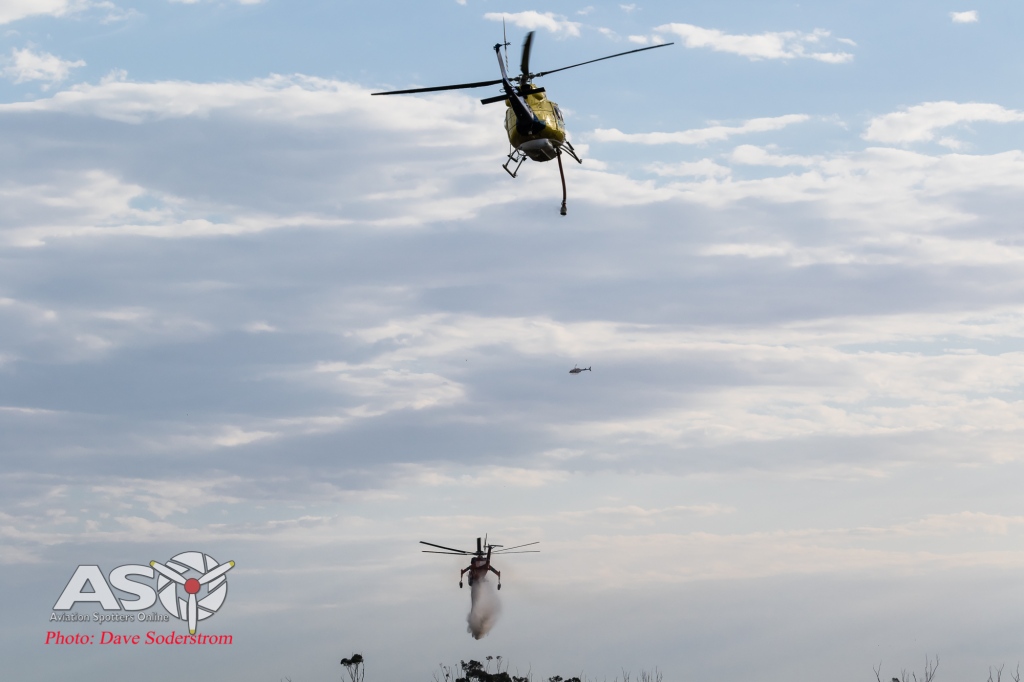
Firebird leads the air attack on a fire north west of Melbourne with AirCrane dropping and Bell 412 following in.
As proved in recent times here in Australia, having a wide and varied mix of aerial fire fighting aircraft allows the local government agencies to best make use of the tax payers dollars. These mix of fixed and rotary wing types are typically contracted through the National Aerial Firefighting Centre (NAFC) based in Melbourne, Victoria on behalf of the Australian jurisdictions. It issues contracts to local and overseas providers of these platforms. State governments and Territories also issue their own contracts, notably in Western Australia DFES has a mixture of NAFC and state contracted aircraft and helicopters. The department managing it is the Department of Biodiversity Conservation and Attractions’ Parks and Wildlife Service (DBCA), which manages aerial firefighting operations for Western Australia.

Ag Air based at Stawell in Victoria had two Air Tractor AT-802As on contract, based at Casterton in Victoria.
The 2017/18 season has seen tenders open to qualified organisations for the provision of aviation services to support the control of bushfires and management of other emergencies across Australia. The tender will see contracts awarded for three years plus two optional one year extensions of these services. This covers the 2018/19, 2019/20 and 2020/2021 seasons. The tenders this year has added requirements for some agencies which included; Specialist Intelligence Gathering (SIG), Night Vision Imaging Systems (NVIS), Winching/Rappelling and Aerial Burning (Aerial Ignition) operations. These operations are of course in addition to the firebombing, air attack supervision, incident observation (air observing) incident mapping, transport, and sling loads already being undertaken. Each state and territory has its own requirements and this is why tenders are issued in conjunction with the organisational structures, and specific requirements of the individual states and territories.
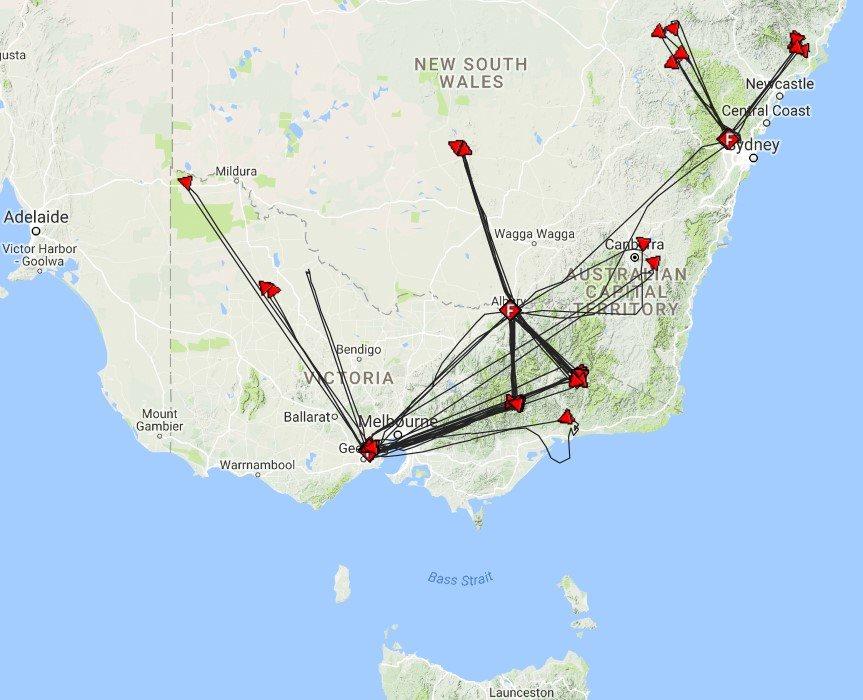
The RJ85 team were kept bust throughout the season. While the aircraft is on contract to the Victorian government the aircraft was called to assist with fires in NSW and near the ACT. As this diagram shows the aircraft performed while being based in Avalon, Albury, Richmond and for the first time Dubbo. (Image provided by FieldAir)

Coulson S-61 conducting a night filling trial. (Image courtesy EMV & Coulson)
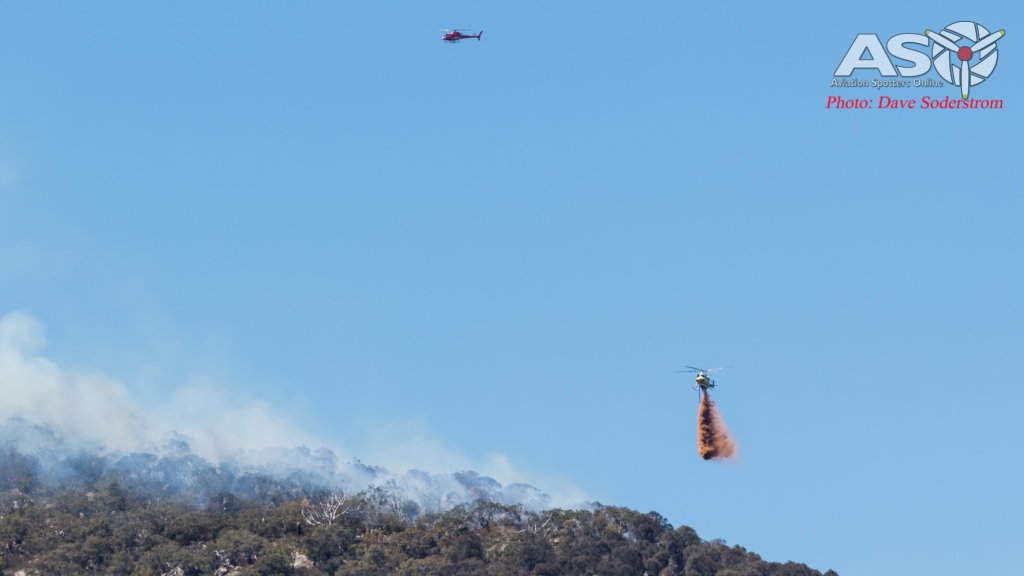
Firebird 307 conducts the drop operations as Helitak 345 drop on a fire at the You Yangs in Victoria.
Aerial Fire Fighting is a large part of many Australian Aviation business. With many local operators well versed in the how, what and where. The local operators have large fleets of both fixed and rotary wing types on contract across the country. Not only is there a huge capital cost in the airframes themselves, pilot training/currency, airframe maintenance, new equipment fit outs etc. These are done to secure a contract in a hotly contested field. Operators are now tailoring their business and aircraft to suit contract requirements, and be at the fore front of the new technologies to give them an edge against the competition.

Right on target, Helitak 345 heads off to refill for the next drop.
Night Fire Fighting…..a new frontier
The single biggest and probably most significant event this fire season wasat Ballarat in conjunction with EMV, CFA, DELWP, NAFC, CASA, Coulson and Kestrel. Developing the night fire fighting capability will allow the undertaking of night filling (hover fill and ground fill) and water drops onto active fire fronts, this change in aerial fire fighting operations should significantly assist ground crews after dark, when previously aircraft would need to be on the ground by last light.
Pilots flying with Night Vision goggles, operating alongside the S-76 which acts as the Supervision aircraft which has an air attack office on board, are able to operate longer and at times when active fire fronts still require fire bombing. The agencies and operators will now integrate the night fire fighting operations in the 2018-19 fire season. The trial was successful and CASA has now approved Coulson Aviation and Kestrel Aviation to undertake night firebombing operations.
ASO has been provided with images and video of this trial and its huge implications for future fire fighting operations. All images are courtesy of Emergency Management Victoria, via Wayne Rigg.

Kestrel’s Helitak 346 prepares to launch during the trials.
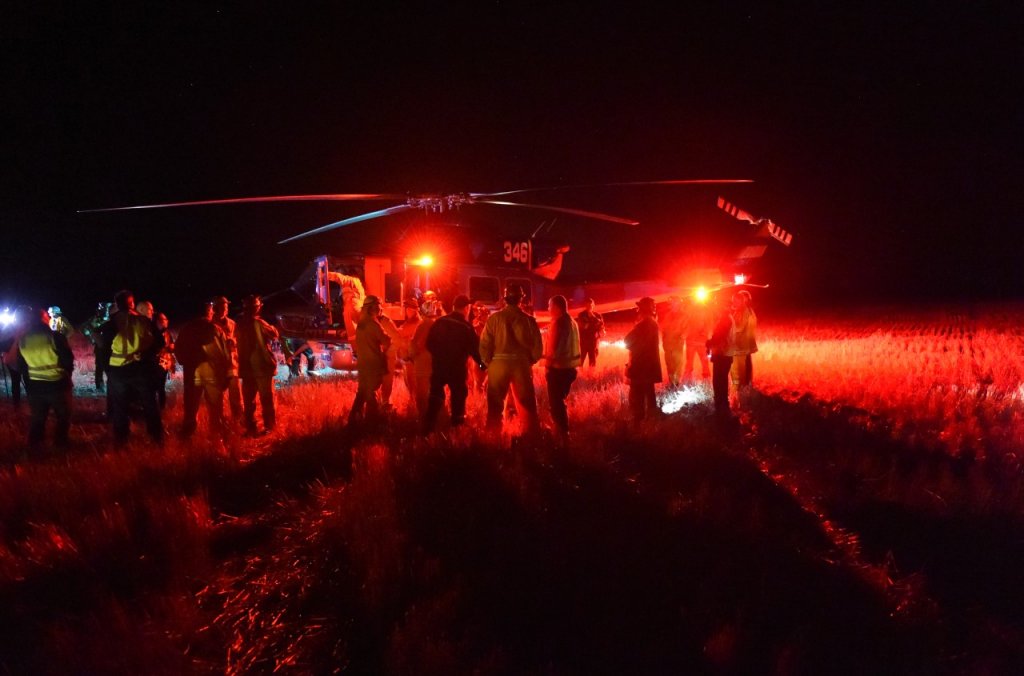
Before each trail, all agencies involved with trial were briefed.

Helitak 347 prepares for launch
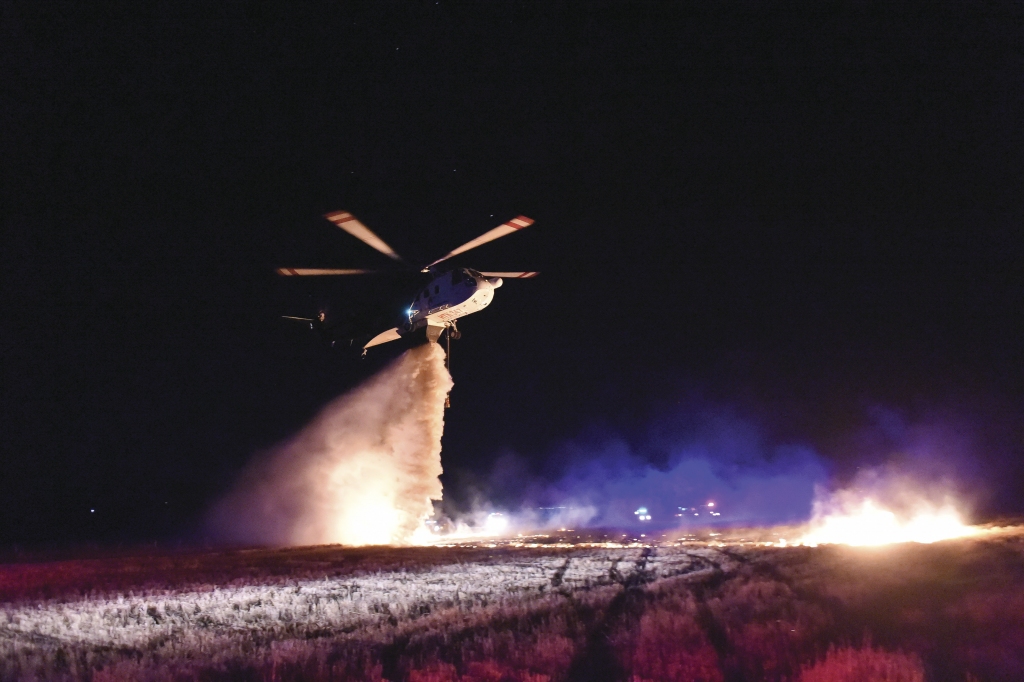
Helitak 347 completes a drop on a simulated fire during the trials

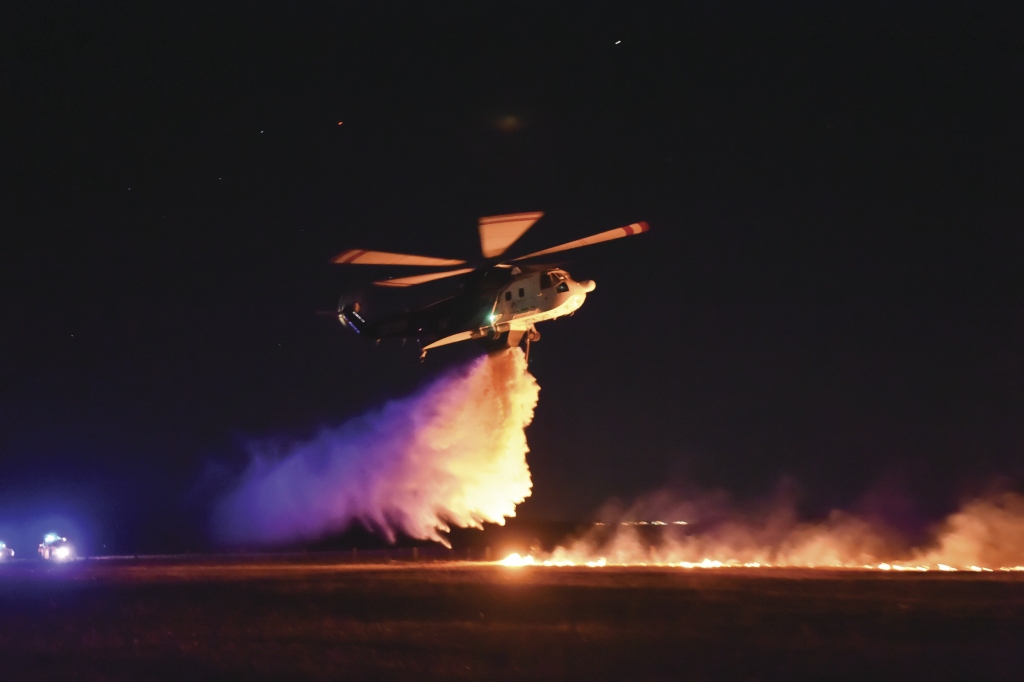

Helitak 346 makes drop on a simulated fire.
See the link below from EMV to see the night trials video.
The NAFC issued tenders to suit the various types of fixed wing aircraft it can mobilise. The types are broken down into five fixed wing types which are based on their water holding requirements. Fixed wing aircraft used for fire bombing will be assigned a type number based on their water carrying capacity and design features, as specified below:
| Type | Engines | Water carrying capacity |
| 1 | Multi engine | Greater than 11,356 litres |
| 2 | Multi engine | Between 11,356 and 6,813 litres inclusive |
| 3 | Multi engine | Less than 6,813 litres |
| 4 | Single engine | Greater than 2,270 litres |
| 5 | Single engine | Less than or equal to 2,270 litres |
Rotary wing aircraft are also broken down into four distinct types.
| Type | Internal payload | Water Carrying capacity |
| 1 | 2,268 kg or greater | 2,650 litres or greater |
| 2 | Between 1,134 kg and 2,267 kg inclusive | Between 1,135 litres and 2,649 litres inclusive |
| 3 | Between 544 kg and 1,133 kg inclusive | Between 380 litres and 1,134 litres inclusive |
| 4 | Less than 544 kg | Less than 380 litres |
Air Attack History
Despite Australia entering the aerial fire fighting game over 50 years ago, it was the United States Air Force and United States Forest Service which were the first to experiment with military aircraft dropping water-filled bombs. The bombs were unsuccessful, and the use of internal water tanks was adopted instead. With large numbers of surplus Word War II and Korean War era aircraft available it was no surprise that airframes like the Consolidated PBY Catalina, Grumman TBM Avenger, Grumman F7F Tigercat, North American B-25, Douglas A-26, Consolidated PB4Y-2 Privateer, Boeing B-17, Lockheed P2V Neptune’s and Douglas C-54s were for a long time the mainstay of the aerial fire fighting fleet, newer purpose-built tankers have since come online.
Today’s modern fire fighting machines in use include modified airframes from roles such as Agricultural spraying and Passenger airliners. These sorts of previous roles provide the fire fighting aviation community with well built and suitably affordable airframes to modify. The well established Aerial Agriculture manufactures, like Air Tractor and Thrush in the United States have taken their proven Ag designs and turned them into extremely capable fire fighting airframes.
There is, as mentioned a large requirement for post airliner service use of airframes when they retire from passenger hauling. Many overseas operators have taken to modifying types like the BAe-146, RJ-85 MD-87, DC-10, Lockheed C-130 and even the ‘Queen of the Skies’ the mighty Boeing 747-400.
International companies helping out
American operators are once again across Australia this fire season. All have brought some of the best fire fighting equipment fielded yet. Operators including 10 Tanker, who have brought the huge Douglas DC-10 to New South Wales on contract to the NSW RFS. Helimax Aviation who in conjunction with local operator United Aero have brought out the Boeing Vertol CH-47D Chinook again on a call as required contract. Erickson Inc, who celebrated 20 years of Air Crane operations in Australia this year has six of the S-64Es across Western Australia, South Australia, Victoria and New South Wales. Also returning for another season and on an as required contract was Timberline Helicopters which brought the UH-60 Blackhawk into the country to be operated alongside local operator Pay’s.

N5630J ‘Thing 2’ at work near Williamtown.
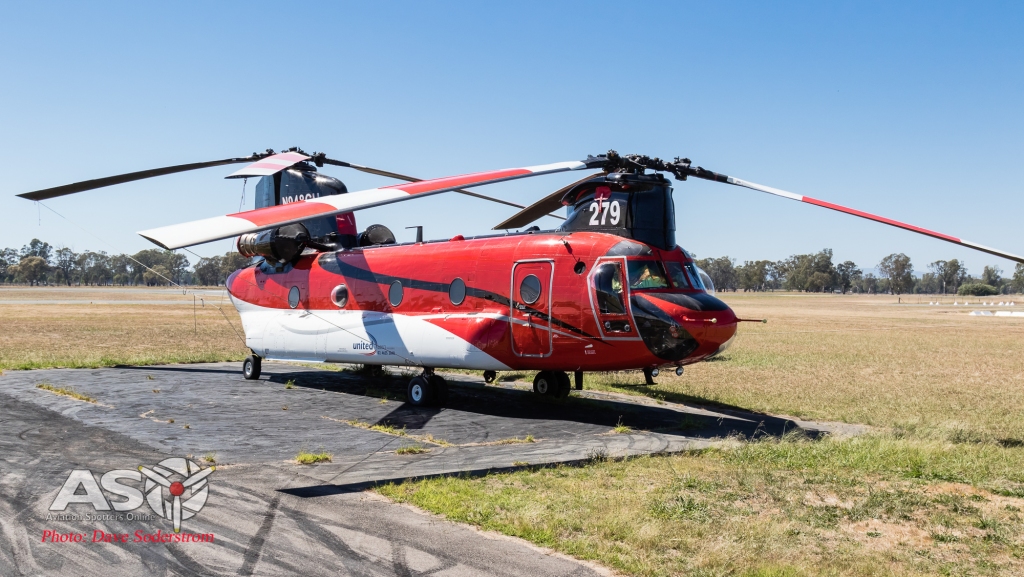
N948CH at rest at Wangaratta.
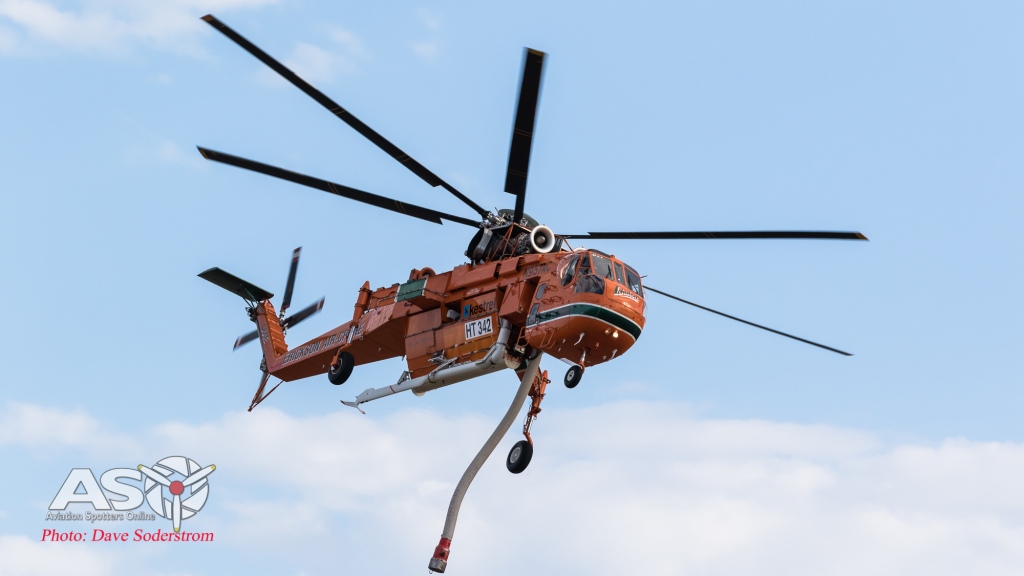
Helitak 342 fighting fires North of Melbourne.

N522AX after completing a drop near RAAF Williamtown, while operating from RAAF Richmond.
The Canadians are also in force across Australia. Several operators and their equipment are in use. These operators including, Wildcat Helicopters, Valhalla Helicopters, Great Slave Helicopters. Alongside the season regulars like Coulson Aviation and Conair with their varied fleets and crews with extensive experience not only on home fires, but in Australia also. One such example is Wildcat Helicopters. They have brought three of their Bell 412s into the country this season. Based in West Kelowna, British Columbia the company was founded in 1998, by husband and wife Mike and Cheryl Michaud as a general aerial service company. As Wildcat Helicopters has expanded, it’s services have grown to become more specialised. In 2004, it was decided to focus the company on the fire fighting market. Today is one of the largest private helicopter companies in Canada. The company operates 11 medium lift aircraft and have a staff of fifty. It’s has a fleet of five Bell 412 helicopters and also has six Bell 212s. Four aircraft are equipped with rescue hoist-and-winch systems. The company had sent three of their Bell 412SP’s to Australia to operate with locally based Camden Operator United Aero. C-FWTQ, C-GBND and C-FWTY were seen in action across New South Wales this season.

C-FWTQ was one of three Bell 412 Helicopters brought in by Wildcat Helicopters this season.
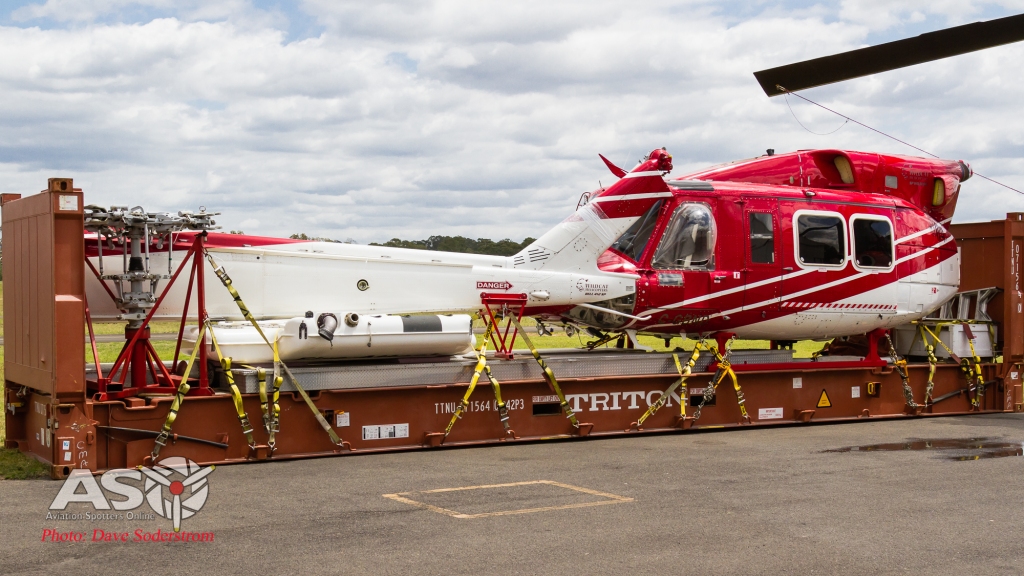
Wildcat Helicopters Bell 412 C-GBND awaiting assembly at the Camden operations base.
Valhalla Helicopters returned again this season with three of their fleet. Bell 205 C-GRUV, C-FPSZ and Bell 212 C-GLFT. They were shipped to Albion Park in Southern NSW. Valhalla commenced operations in the spring of 2003, and is owned by Blair Savege. In 2010, the company developed an international presence by creating a sister company, Valhalla Helicopters Pty Ltd, with a base of operations at the Illawara Airport. The companies commitment to operations in Australia saw Blair, complete the training, exams and proving flights with Civil Aviation Safety Authority (CASA) to secure his Australian commercial helicopter license, in order to fill the position as Chief Pilot for Valhalla Helicopters Pty Ltd Australia.

Valhalla Helicopters Bell 205 C-GRUV flying as ‘Helitak 253’, this season on a call as required contract operated from Illawarra Regional Airport in Southern New South Wales.
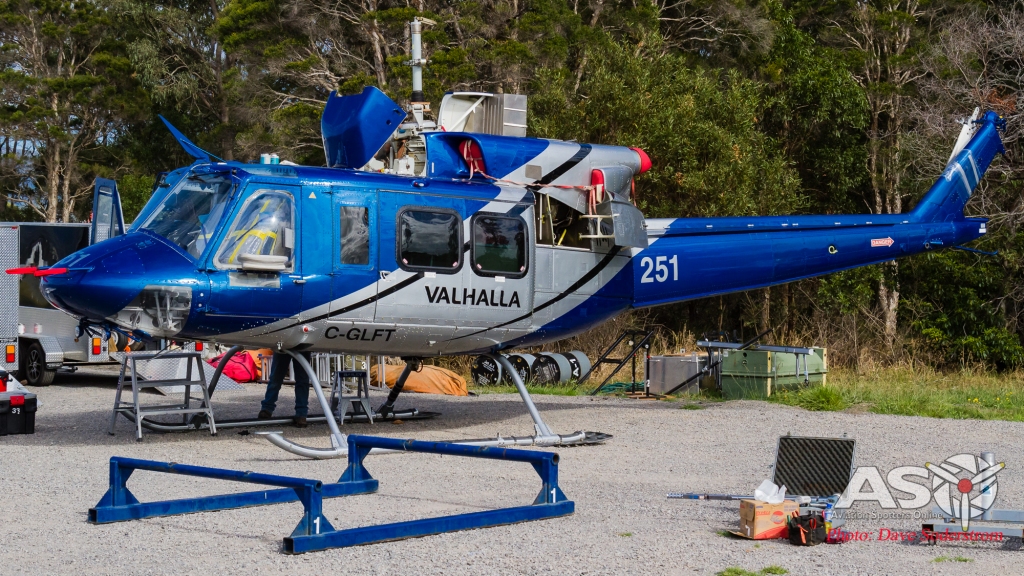
Valhalla Helicopters Bell 212, C-GLFT under assembly at Albion Park NSW.

Two machines are seen here later in the season stationed at Mudgee Airport in NSW.
Great Slave Helicopters, another Canadian operator based at Yellowknife, in the Northwest Territories. The company was established in 1984 and toady with their varied fleet today offer a wide range of services. Mining exploration and fire suppression, heli-sking, air ambulances and military support missions are some of the missions undertaken by GSH. The company is subsidiary of the Discovery Air Inc Group, flying types like, Bell 205, 206, 212, 407 along with BK117, AS350 and 335s. Jayrow Helicopters based at Moorabbin in Victoria have contracted C-FNTR this season to fly on a call as needed contract as Helitak 237.

Great Slave Helicopters Bell 205, C-FNTR on standby in Bendigo.
Conair also based in British Columbia has been operating fire fighting equipment for more than 40 years. Having operated types like Douglas DC-6, Lockheed Electras, and Convair 580s. The company was at the fore front of development of the BAe-146/RJ fire fighting conversions. In 2009 the company flew a fully ballasted and instrumented BAe-146-200 to test the concept. The company selected the modernised version the RJ-85 as there is enough airframe life for 25 odd years of service. Working in conjunction with the manufacturer (BAe) the two companies developed the external tank modifications which envelopes the fuselage. The 11,350 litre tank capacity fitted with a constant flow firebombing system, is located centrally so as to have no pitch issues when on a bombing run. Conair in partnership with locally based Victorian operator FieldAir again teamed up on contract to the Victorian State Government with the BAe RJ85. The aircraft provides excellent low speed and high speed performance thanks to its fowler flaps. This season as it had previously the aircraft was called upon to operate against the fires in New South Wales.
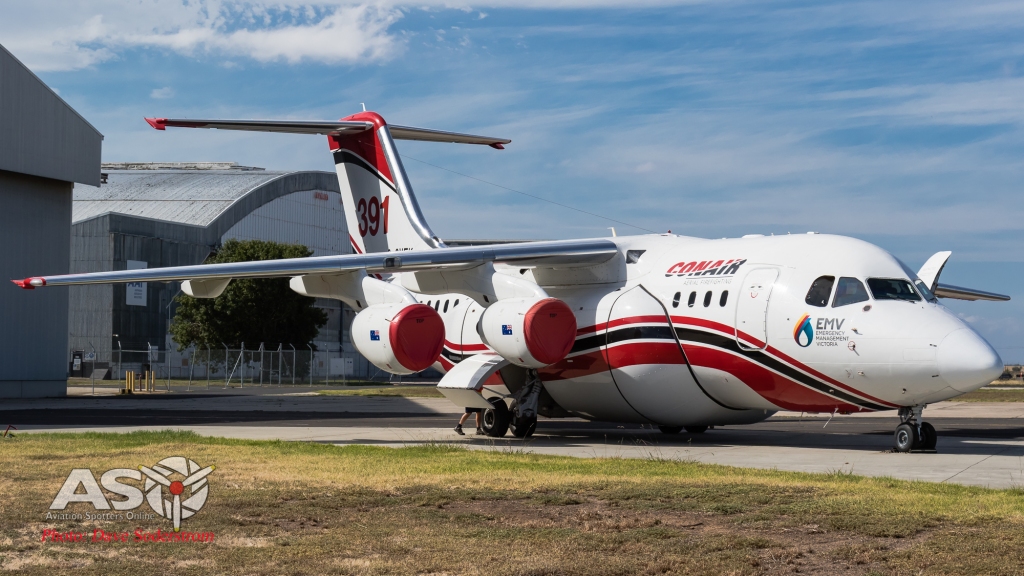
Bomber 391 rests at is Avalon Airport operating base.
Coulson Aviation was established in 1985 and are based in Port Alberni British Columbia, Canada. The company traces its roots back to the family business of logging in British Columbia, Canada. The company has continued to grow and now has a large fleet of aircraft which are deployed across Canada, USA and Australia. As its operations grew, so did the need to establish a local entity in Australia so in 2010 Coulson Aviation PTY was established in Australia to coordinate its operations. The company now has three Lockheed C-130 airframes converted to fire bombers, with a forth due to begin flight testing later this year.
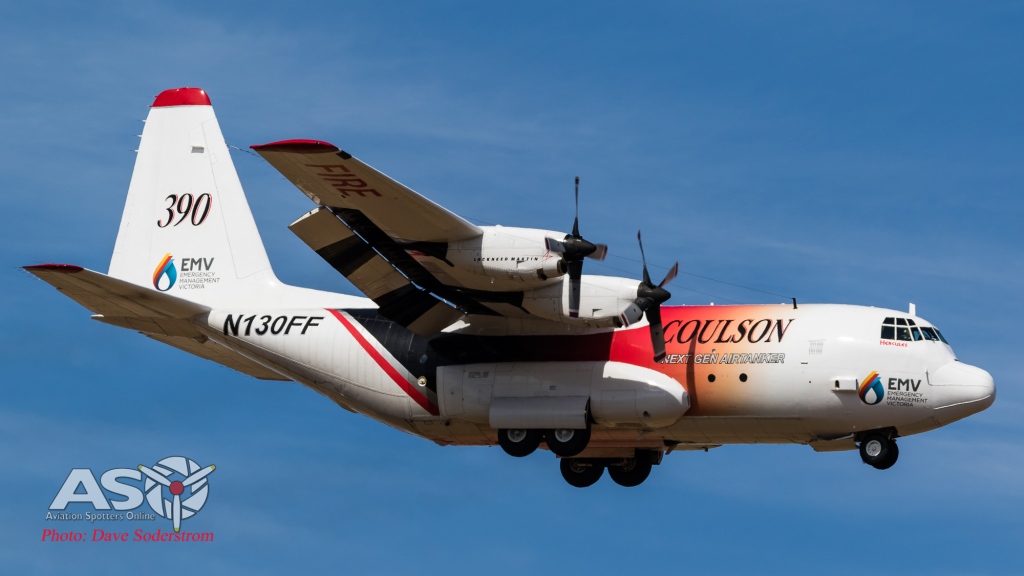
N130FF arrives at Avalon Airport ahead of standing up for the 17/18 Season.
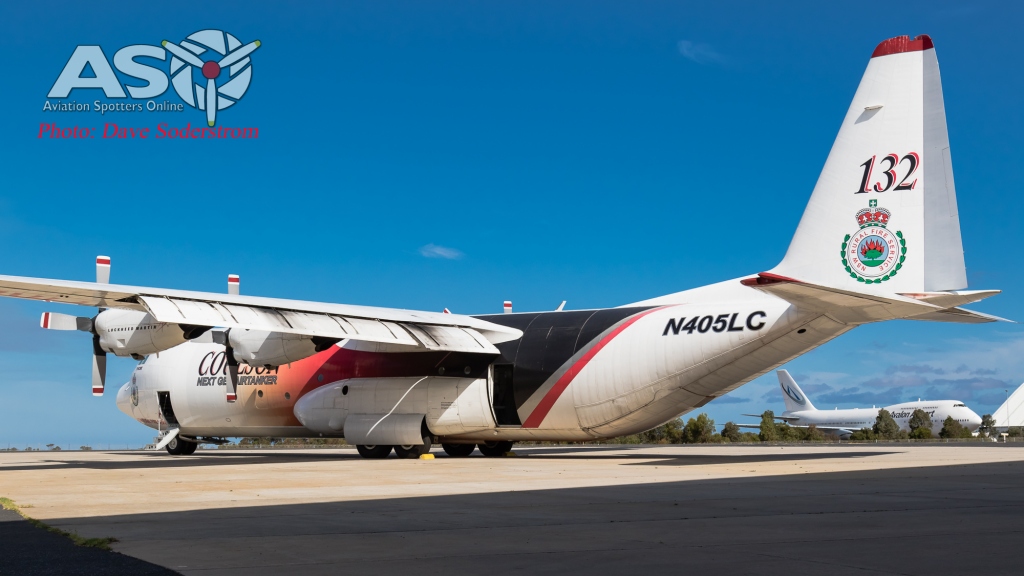
Due to the delay of N130FF in arriving in Victoria, N405LC stood in until the it could make it into the country.
Coulson provided several fire attack airframes this season. The New South Wales Rural Fire Brigade had Lockheed L-100-30 N405LC, at its disposal this season based at RAAF Richmond north of Sydney. The Country Fire Service in Victoria contracted C-130Q N130FF for the season as well as two Sikorsky S-61s C-FIRX and N161CG. Imported late in the season was Sikorsky S-76 C-FIRW, for use in the night fire fighting trials.

Helitak 347 spent most of its season based at Colac in South West Victoria
New operators in the game…..
A new company on the scene in the future will be StarFlight Australia. The company plans to bring ten Sikorsky UH-60 Black Hawk helicopters into Australia, with options for an additional 10 aircraft. A refurbishment program which is to be undertaken in Brisbane by Sikorsky, will see the ten ex-US Army Black Hawks, brought up ‘to as new’ condition and re-purposed specifically for aerial firebombing operations during future bushfire seasons around Australia and New Zealand and for year-round emergency services and disaster relief work. Starflight is the Australian division of, Kaan Air one of Europe’s leading helicopter utility operators and a helicopter manufacturer (OEM) distributor for Agusta-Westland and Russian helicopters. The company has significant operational experience in helicopter fire fighting, off-shore and Air Medical Service businesses
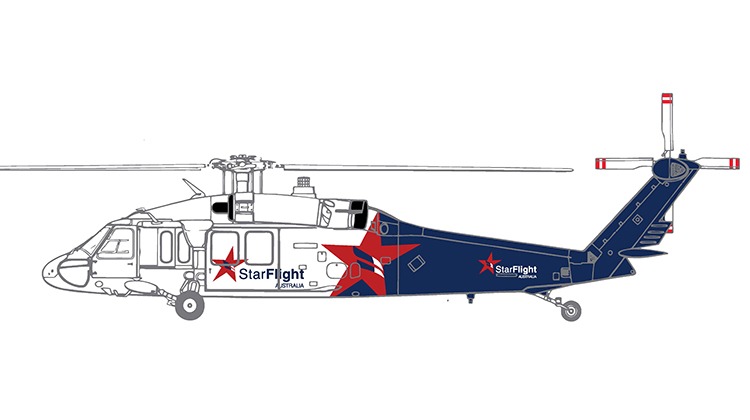
Image of the proposed StarFlight UH-60A Blackhawk
Fixed Wing fleet types within Australia.
Air Tractor Fleet
In Australia many types operate as well established platforms. Local operators employ large numbers of the rugged and suitably capable Air Tractor. This season some forty examples were either on contract or available on an as required contract across the country. Twelve alone were on contract in Victoria from operators including Field Air, Ag Air, Pay’s. Western Australia had eleven on contract this season through Dunn’s. Most numerous in the fleet are the AT-802F and AT-802F FireBoss float equipped version. The Air Tractor with its 3200 litre tank capacity, agility and robustness make it an extremely capable weapon of attack. This past season saw the “harvest bomber” concept demonstrated to good effect again in Victoria . Field Air had two AT- 802s in the programme – situated at Ouyen and then across to Kerang as the harvest progressed. Ag Air was also involved with two 802’s based at Nhill for the harvest period. A rotor wing aircraft was also stationed in the Mallee for the harvest period.

Field Air’s ‘Bomber 715’ a AT-802A was noted at Ballarat with spray booms attached prior to having them removed for the fire season.
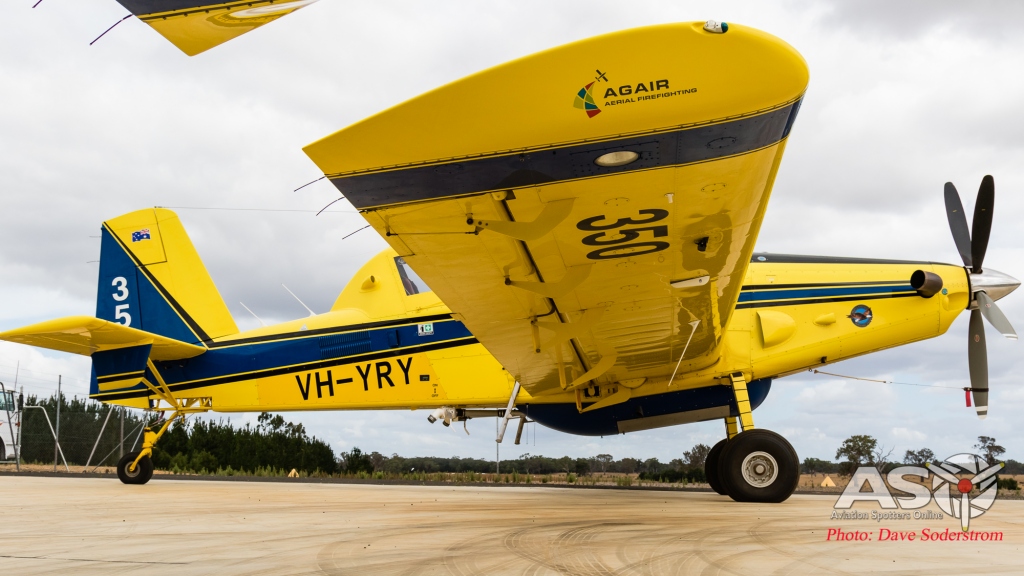
AGAIR’s AT-802 VH-YRY on standby at Casterton.
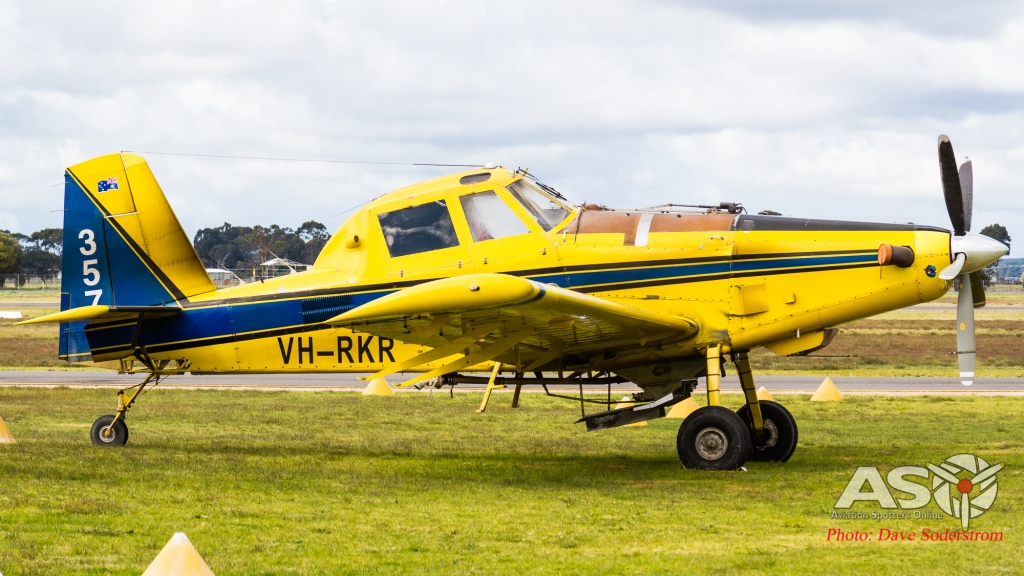
Ag Air’s AT-802 Bomber 357 sits at rest at Mount Gambier Airport in South Australia
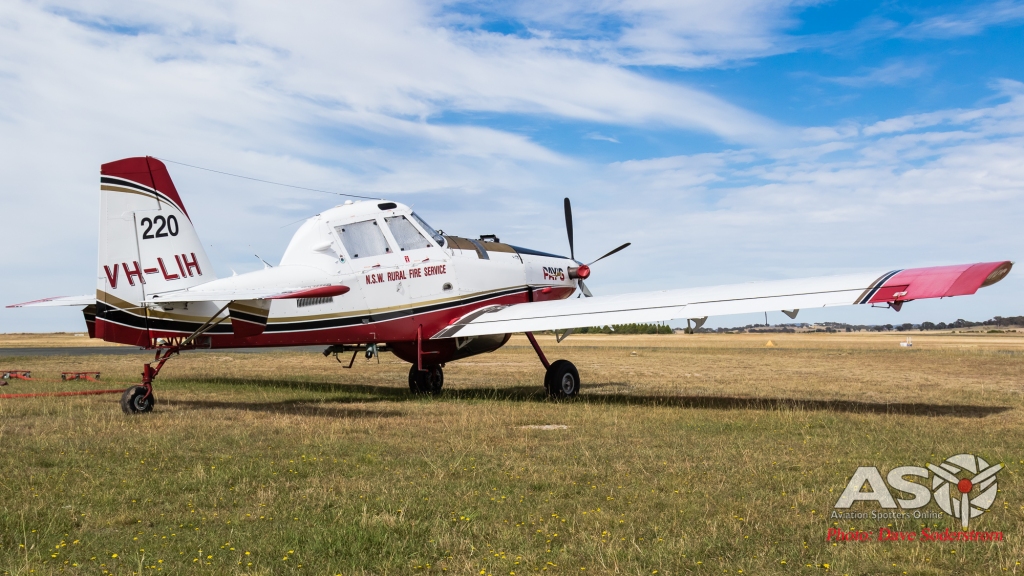
Pay’s Air Service’s AT-802 noted at Goulbourn NSW on contract.

Air Tractor AT-802 VH-NTM from Aerotech, N.T Seen conducting a drop on a fire on the outskirts of Darwin Airport.
Air Tractor AT-802 Overview:
- Single Engine Air Tanker
- Call sign “Bomber”
- Single pilot crew 3200 litre capacity
- 7250 kg gross weight
- Drop speed 200 km/h
- Cruise speed 350 km/h
- 11 m length, 18 m wingspan,
- P&W PT6A turboprop engine 1350-1600 HP
- Fuel consumption 280 litres/h of Jet A1
- Gen II Fire Retardant Dispersal System
- Fire retardant or fire suppressant
- 4+ Radios &
- Satellite tracking
Pay’s Air Service operate three of the Fire Boss version alongside seven fixed undercarriage versions.

VH-FBX scooping water on the lake to fight the Peat fire in South Western Victoria this year. (Image courtesy, Wayne Rigg EMV)

The shear size of the Fireboss is evident here.

VH-FBX from Pay’s was stationed on contract at Albury Fire Base.

Powered by the Pratt & Whitney PT6A-67F which delivers 1,600 Horse power @ 1,700 RPM.
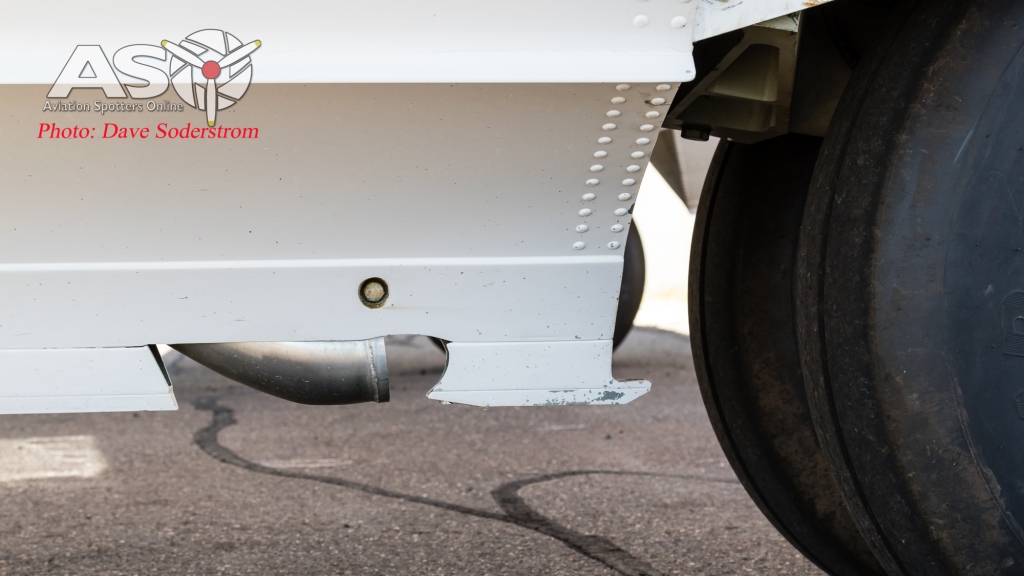
Filling Scoop in the retracted position.
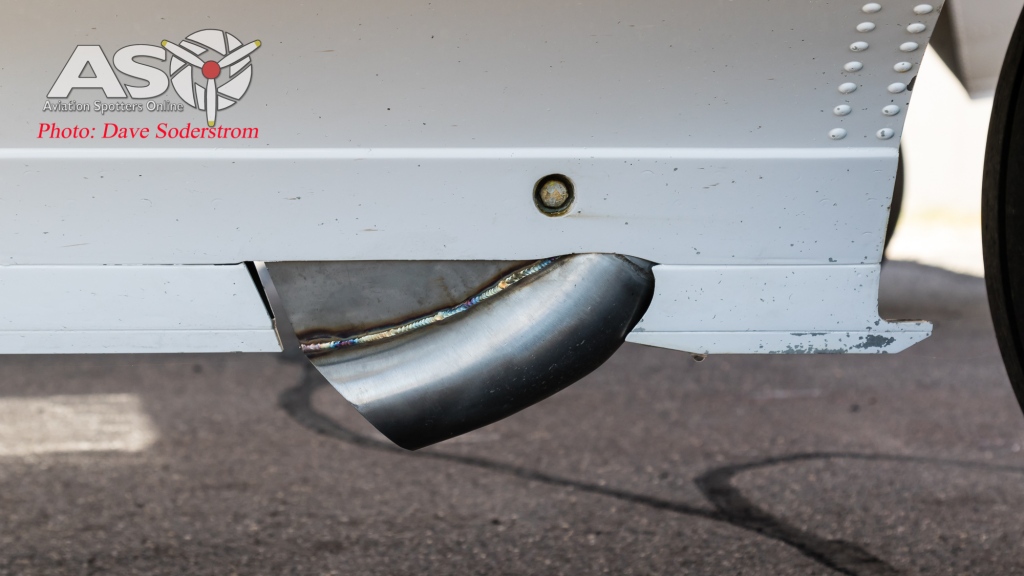
Filling scoop deployed, which allows the filling of the 3028 Litres of water for fire use.
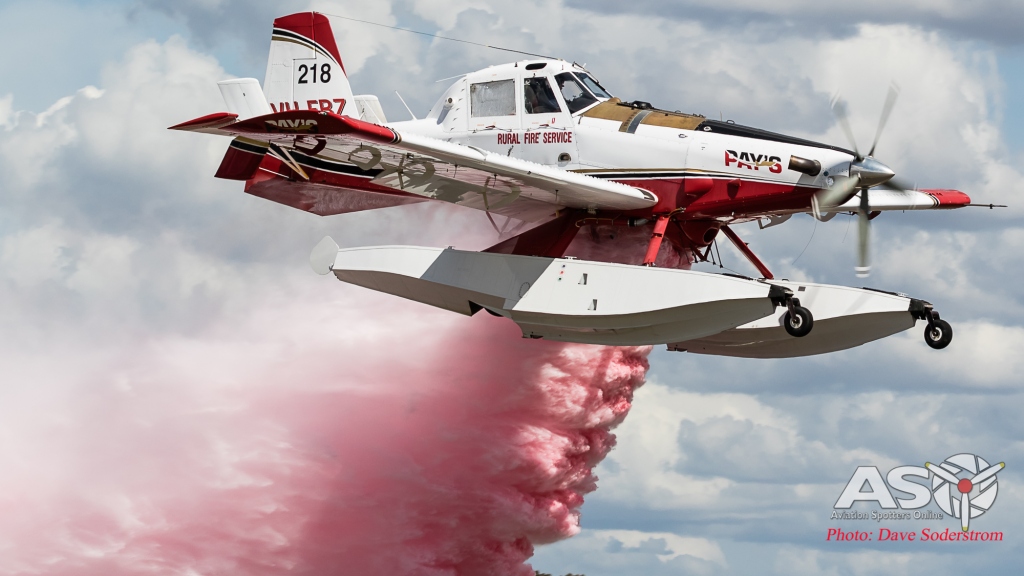
VH-FBZ preformed a water drop at the Scone Airshow this year.
Part of the Dunn Aviation Fleet head out to a fire not far from their Jandacot Base. (Image from Brenden Scott)
Air Tractor AT-602
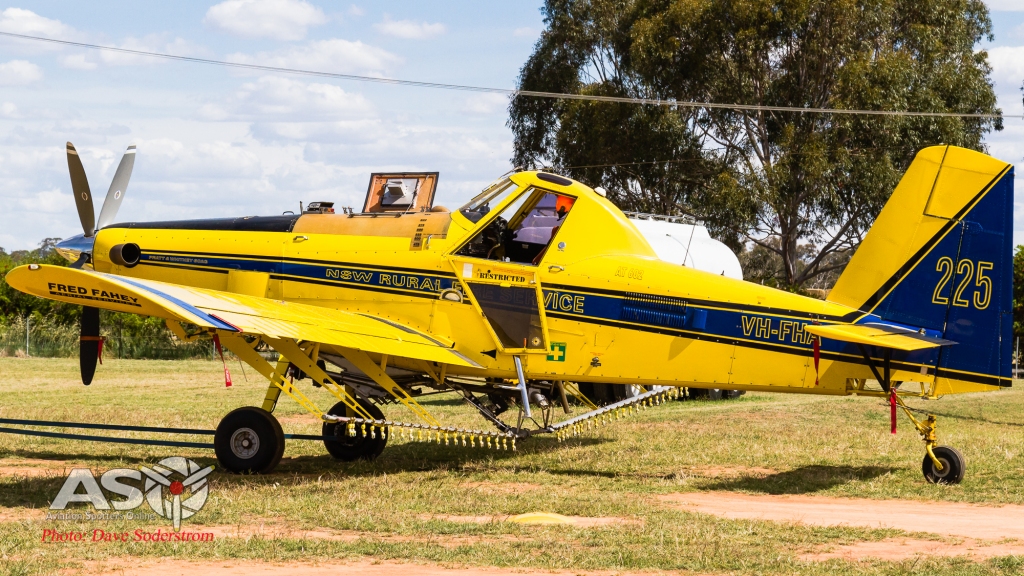
VH-FHA an AT-602 its self a smaller version of the AT-802 is owned by Fred Fahey and flies as Bomber 225 on behalf of the New South Wales Fire Service.
Cessna 208 Caravan
The Cessna Grand Caravan continues to prove its versatility on the fire ground. The type flies mainly in the air supervision role and also acts as transport for fire officials and other crews to quickly get on scene as required.

VH-TWX, or ‘Birddog 375’ sits at the ready at Firebase Albury
208B Grand Caravan Overview:
- Call sign “Birddog”
- Primary role: air attack supervision
- Other roles: reconnaissance / utility aircraft
- Single engine, turbo prop, high wing
- Single pilot, nine passengers
- 3950 kg gross weight
- Cruise speed 300 km/h
- 12.7 m length, 15.8 m wingspan,
- 675 HP Pratt & Whitney PT6A-114A Turbo shaft engine
- Three bladed constant speed reversible propeller
- Fuel consumption 175 litres/h of Jet-A1
- Day, night and instrument flight
- Up to 6 hours endurance
- 2+ fire agency radios
- Satellite tracking
The lead in aircraft type for the Large Air Tankers and Very Large Air Tankers is the Rockwell Aero Commander. It’s main role is to direct the activities of the air tankers by both verbal target descriptions and by physically leading the drop profile to show the airtanker where to fly and to identify hazards and landmarks. In some circumstances the Turbo Commander can be used to lead the airtanker through its drop pattern and generate a smoke marker trail at the required drop location. The on board air attack supervisor will direct air tankers where and how to drop their load on the fire. .Other roles include the ability to supervise aerial fire fighting operations and to collect intelligence information about a fire and pass it on to the incident management team.
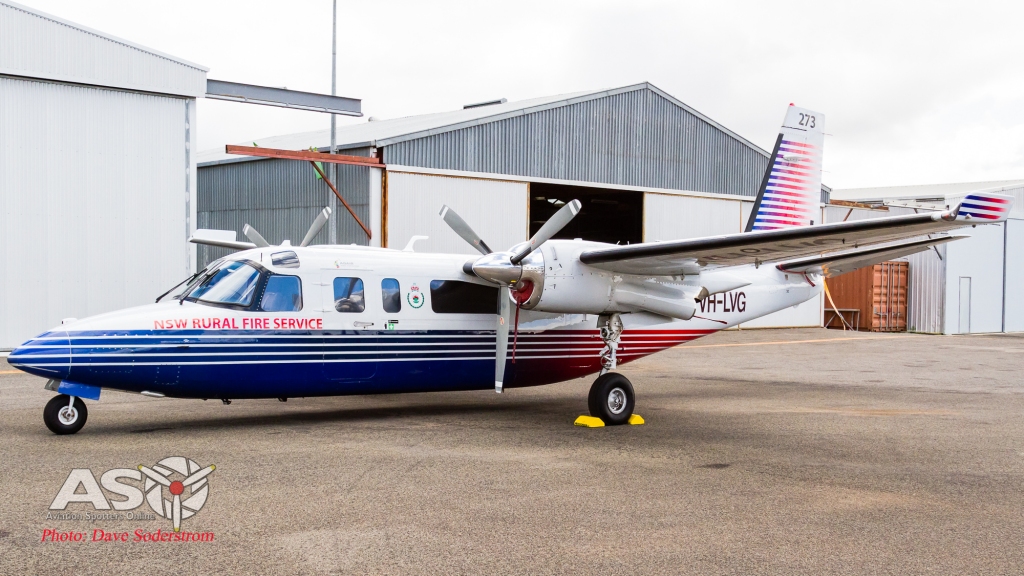
VH-LVG which is part of the AG Air fleet, seen here prior to being deployed to Sydney to support the VLAT DC-10 at RAAF Richmond.
Commander Overview:
- Call sign “Birddog”
- Primary role: air attack supervision
- Other roles: reconnaissance / utility aircraft.
- Twin engine, turbo prop, high wing
- Single pilot, 5 passengers
- 4650 kg gross weight
- Typical cruise speed 500 km/h
- Typical cruise altitude 18,000 feet
- 13.5 m length, 14.2 m wingspan
- 2 x 717 HP Garrett TPE 331-10 engines
- Fuel consumption 300 litres/h of JetA1
- Day, night and instrument flight
- More than 3.5 hours endurance
- 2+ fire agency radios
- Satellite tracking
- Smoke trail generator
Beechcraft B-200 King Air
In recent years the uptake of fire scanning has grown. The B-200T King Air operates alongside other fire fighting aircraft to support fire fighting crews on the ground. Carried on board the aircraft are sophisticated communication and tracking equipment that keep the aircraft in constant contact with other aircraft and the fire agency crews managing fires on the ground.
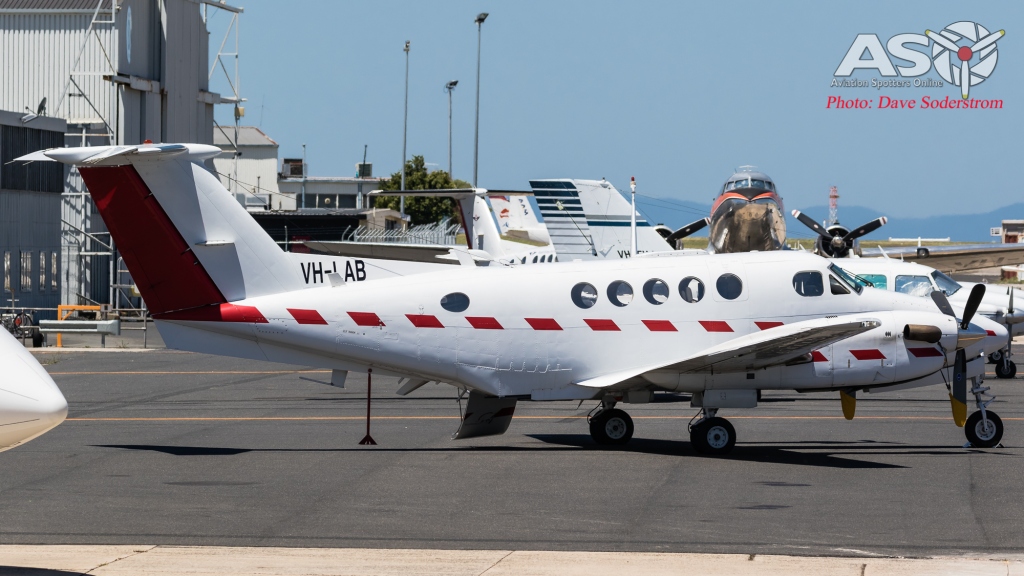
VH-LAB which is part of the Air Affairs fleet based at Nowra in NSW.
B-200T King Air Overview
- Call sign “Firescan”
- Primary role: Fire Scanning
- Other roles:Reconnaissance / utility
- Twin engined turboprop
- Single pilot, one system operator
- Operating speed 245 Knots ( 450 km/h)
- 1300m Runway required normal ops
- 6100 kg maximum take-off weight
- 13.3 m length, 16.8 wing span
- Two P&W PT6A-42 turboprop engines
- Fuel consumption 340 litres/h of Jet-A1
- Infrared and multispectral line scanner
- Satellite broad band data transmission
- 2+ fire agency radios, Satellite tracking
Cessna 337
Also flying in the Birddog role is a number of Cessna 337s. These aircraft provide great fire observation platforms. Several are on an as required contract for the fire season.

Aerovision based in Ballarat operate VH-ZEV a Cessna 337 as Birddog 373. The vision from the cabin windows makes it an excellent observation platform. (Image courtesy Wayne Rigg EMV)
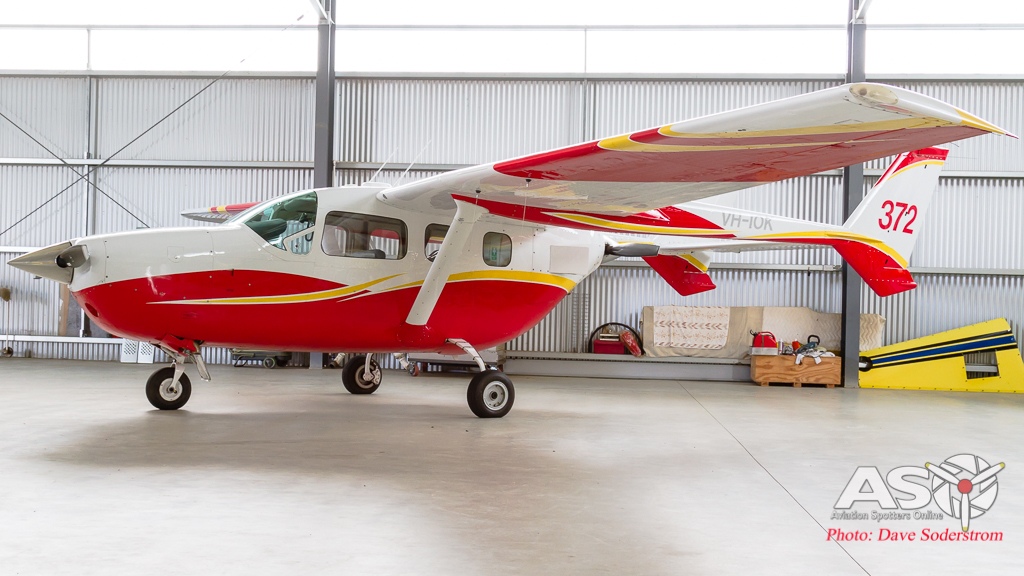
VH-IOK is a Cessna 337G, part of the AGAir Fleet. It flies as Birddog 372
Cessna 337 Overview:
- Call sign “Birddog”
- Primary role: air attack supervision
- Other roles: reconnaissance / utility aircraft.
- Twin engine, turbo prop, high wing
- Single pilot, 5 passengers
- 4650 kg gross weight
- Typical cruise speed 500 km/h
- Typical cruise altitude 18,000 feet
- 13.5 m length, 14.2 m wingspan
- 2 x 717 HP Garrett TPE 331-10 engines
- Fuel consumption 300 litres/h of JetA1
- Day, night and instrument flight
- More than 3.5 hours endurance
- 2+ fire agency radios
- Satellite tracking
- Smoke trail generator
Gippsland GA-8 Airvan
The Gippsland GA-8 Airvan is an indigenous Australian design. The Airvan first flew in 1995 and was designed to fill a market niche perceived by the manufacturer between the Cessna 206 and Cessna 208 models. Currently a single Airvan has been modified by Griffith based operation, Skycroppers for Fire Mapping role. The incorporation of real time mapping technology technology into the airframe allows the fire line perimeter to be digitally outlined. This in turn gives an accurate measurement of acreage within the fire perimeter.
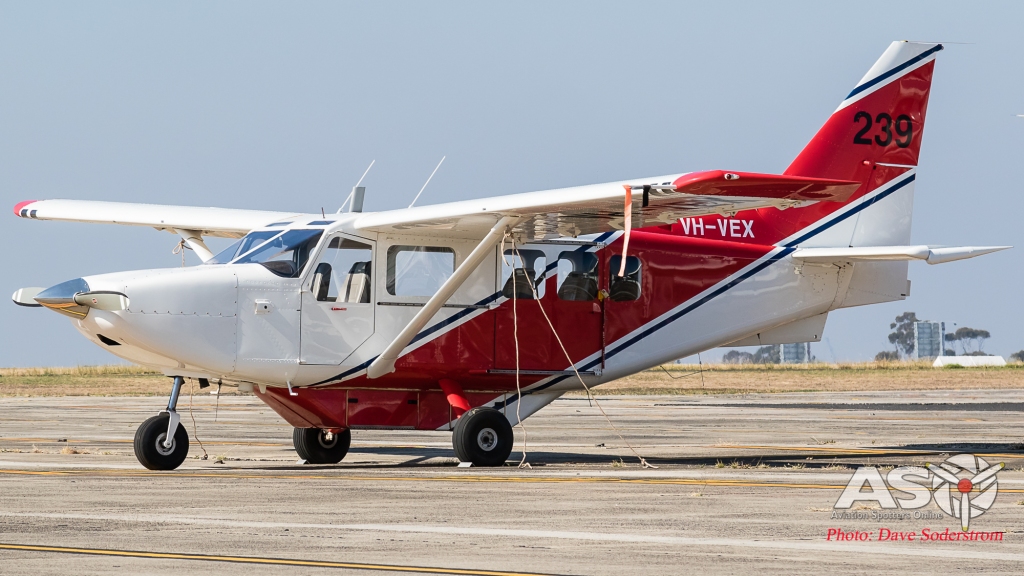
VH-VEX owned by Skycroppers in Griffith sits on the ground at Essendon.
Gippsland GA-8 Airvan Overview:
- Crew: 1
- Capacity: 7 passengers
- Max takeoff weight: 1,814 kg (3,999 lb)
- Fuel capacity: 340 L (74.8 Imp Gallons)
- Powerplant: 1 × Textron Lycoming IO-540-K1A5 air-cooled flat-six, 220 kW (300 hp)
- Maximum speed: 241 km/h (150 mph; 130 kn) at 1,525 m (5,000 ft)
- Cruise speed: 222 km/h (138 mph; 120 kn) at 3,050 m (10,000 ft)
- Range: 1,352 km (840 mi; 730 nmi)
- Endurance: 6 hr
- Service ceiling: 6,100 m (20,000 ft)
American Champion 8GCBC Scout
The Scout is used heavily in Western Australia in the Fire Spotter Role. Several are on contract to the Parks and Wildlife Department in the state.
Department Of Parks And Wildlife Fire Mgmt Service, VH-KTG heads out on another Patrol form Jandacot. (Image from Brenden Scott)
Department Of Parks And Wildlife Fire Mgmt Service VH-PWC heads out for a fire spotting mission. (Image from Brenden Scott)
- Call sign “Fire Spotter”
- Primary role: air attack supervision
- Top speed: 225 km/h
- Range: 684 km
- Cruise speed: 180 km/h
- Weight: 635 kg
- Engine type: Lycoming O-360
Douglas DC-10 (Very Large Air Tanker- VLAT)
The DC-10 airtanker has been used by fire agencies in both North America and Australia. Its primarily use if for line building with fire retardant on larger fires. The DC-10 typically operates with a ‘lead plane’ or Birddog that flies ahead of the DC-10 during the firebombing drops and directs where the load is to be placed. The DC-10 can only operate from a limited number of larger airports across Australia like Richmond and Avalon as examples. With a full 43,900 litre retardant load on board and when the mercury reaches as high as 45 degrees Celsius the aircraft requires a runway length in excess of 2,000m. The DC-10 requires more consideration of runway and taxiway pavement strengths and clearances than other fire fighting aircraft due to its heavy loadings. On board the aircraft are sophisticated communication and tracking equipment that keep the aircraft in constant contact with other aircraft and the fire agency crews managing fires on the ground and in the air.
The N.S.W Government has contracted, through the NAFC, one DC-10 this season. N522AX or Bomber 912 was given a uniquely Australian name when it arrived in the country. At the launch event for the NSW fleet the aircraft was christened, in honour of renowned Australian aviator Nancy Bird Walton AO OBE after one of our most famous female aviatrix.
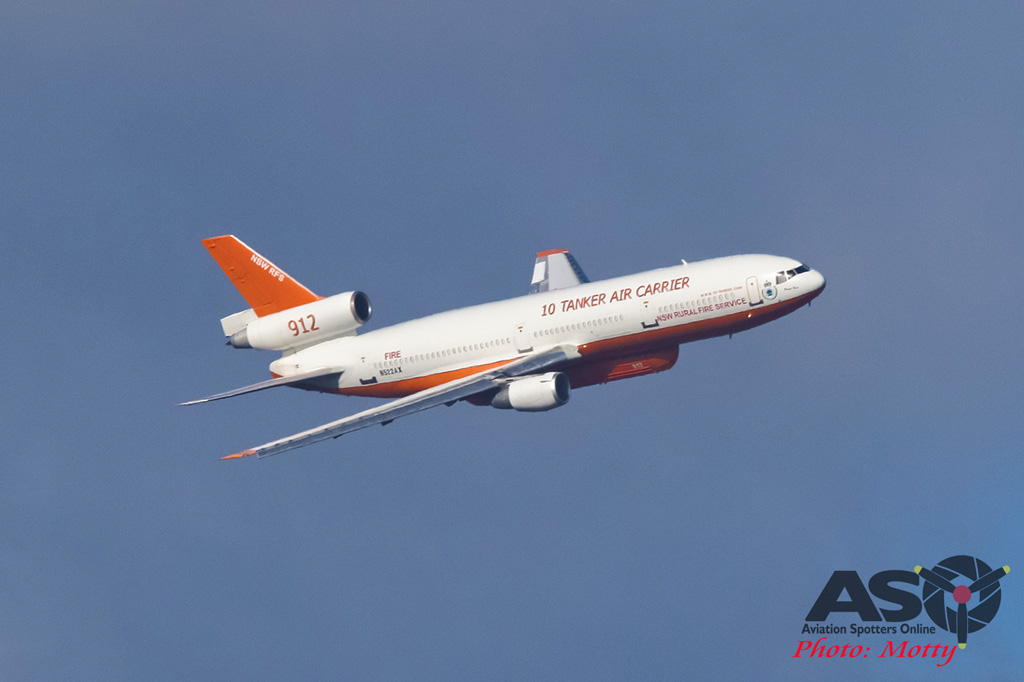

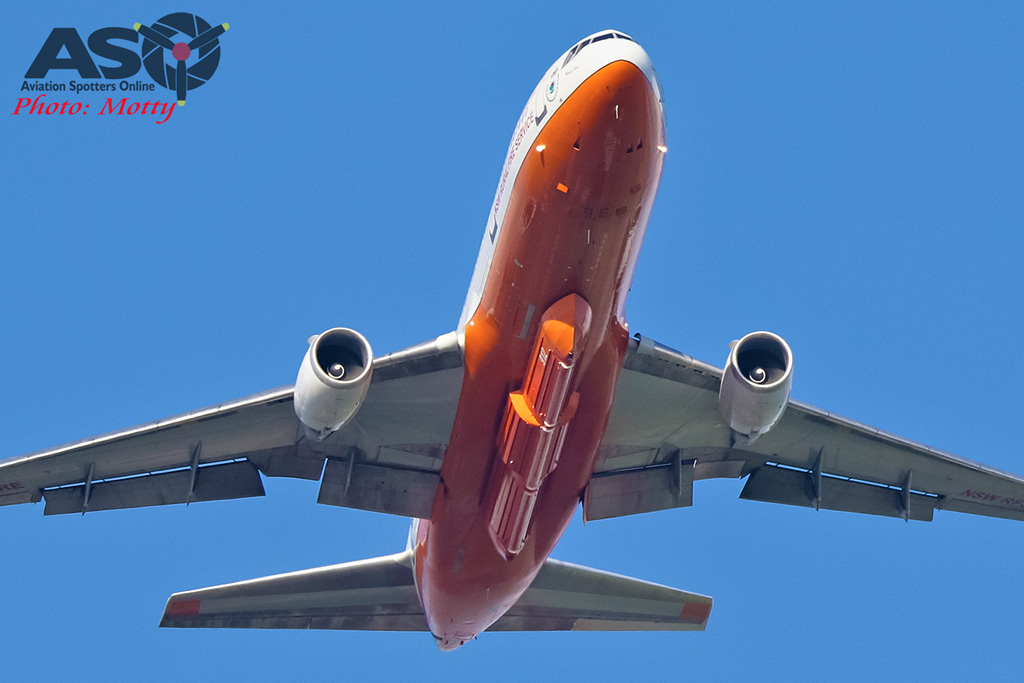
The firebombing system is a derivative of Erickson Aircrane helicopter tank specially modified to suit the DC-10.

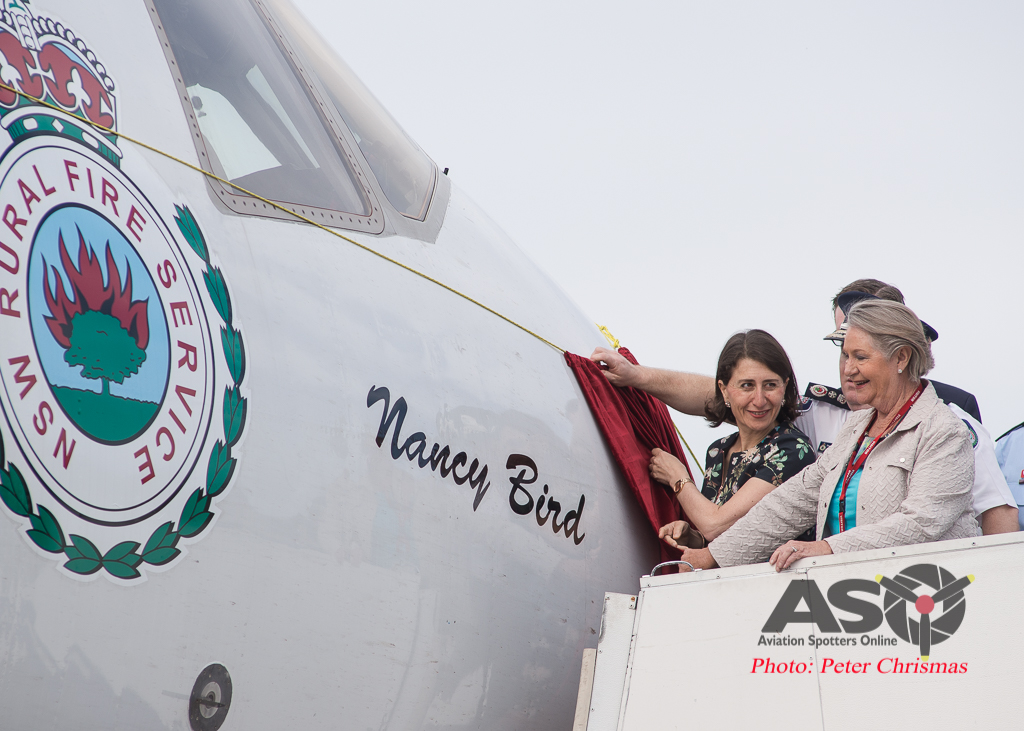
Premier Gladys Berejiklian, Minister for Emergency Services Troy Grant and Treasurer and Member for Hawkesbury Dominic Perrottet where among the dignitaries a the naming ceremony at RAAF Base Richmond.

Douglas DC-10 Overview:
- Type 1 VLAT airtanker
- Primary role: Firebombing
- Crew of two pilots and one flight engineer
- 5 tanks, underslung, constant flow firebombing system
- 43,900 litre retardant capacity
- Drop speed approximately 280 km/h
- Typical cruise speed 650 km/h (loaded), 830 km/h (empty)
- Typical cruise altitude 12,500 ft (loaded), 27,000 ft (empty)
- Typical runway required 2,000+m
- 55.5m length, 50.4m wingspan
- 190,500kg Maximum takeoff weight
- 3x General Electric CF6-50C2 turbo fan engines
- Fuel consumption 9,650 litres/h of Jet-A1
- 2+ fire agency radios
- Satellite tracking
BAe RJ85
Conair in conjunction with Ballarat based company Field Air have again contracted a single BAe RJ85 to operate as part of Victoria’s LAT aircraft operation. Conair operate several of the RJ85.

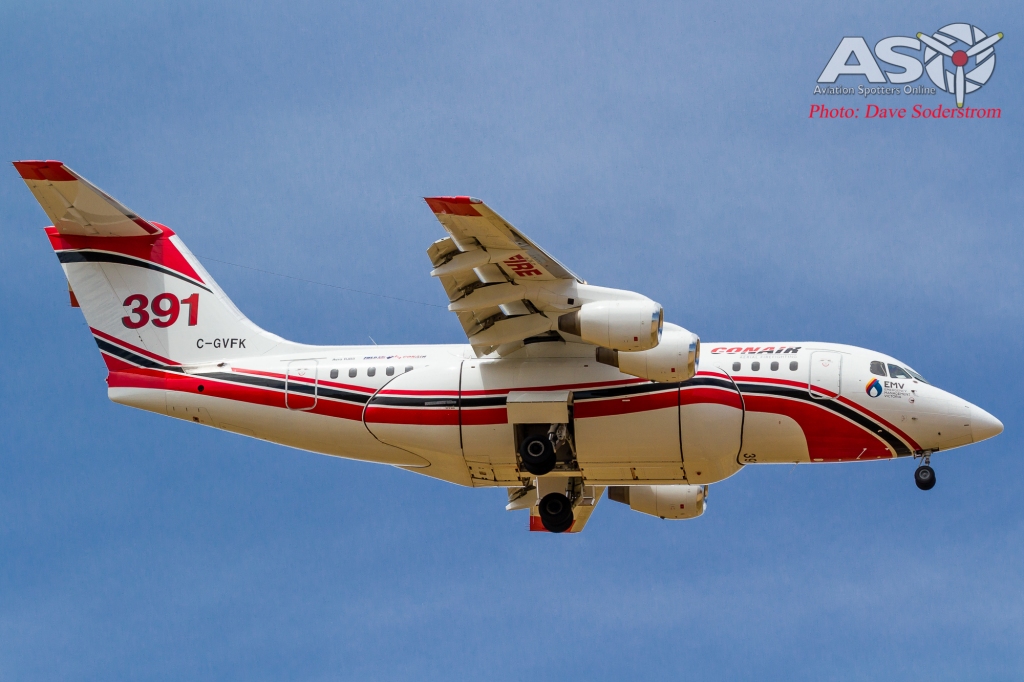
This season the RJ85 worked from Avalon, Albury, Richmond and for the first time Dubbo.
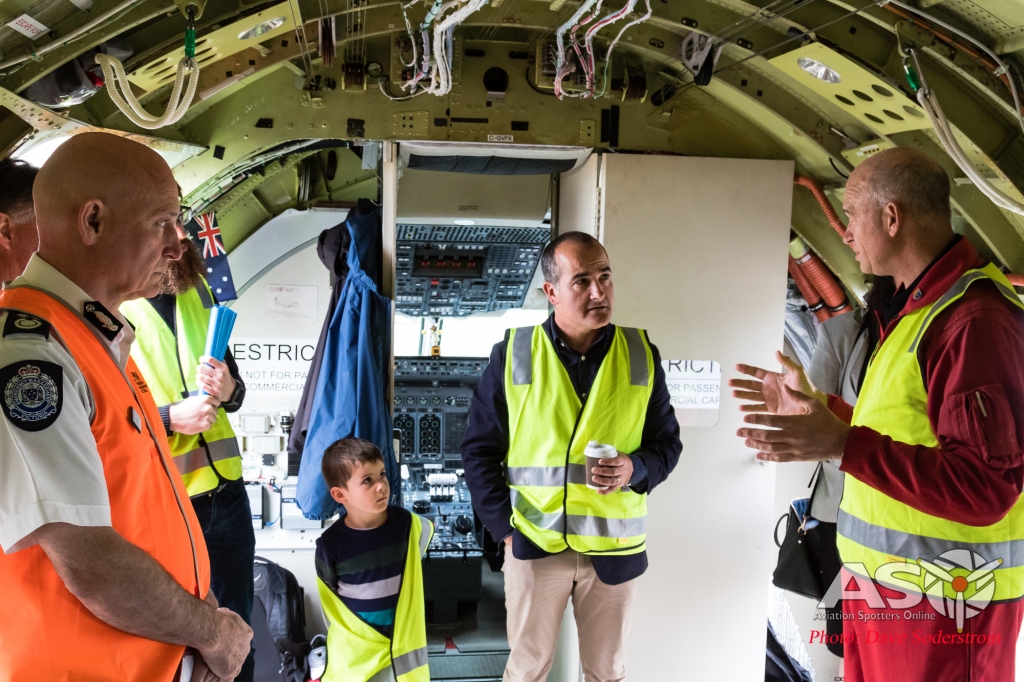
Victorian Minister of Emergency Services, James Merlino and Craig Lapsley, Emergency Management Commissioner listen to one of the RJ Crew, explain how the application of the RJ’s technology on the fire ground.
RJ85 Overview:
- Type 1 Airtanker
- Primary role: Firebombing
- Two pilots when firebombing
- Conair constant flow firebombing system 11,350 litre retardant capacity
- Cruise speed (loaded) 680 km/h
- Typical cruise altitude (loaded) 18,000 feet
- Typical runway required 1,650m
- Max runway required (full load hot day) 1,950m
- 28.6 length, 26.3m wingspan
- 42,200 kg gross weight
- 4 x Honeywell LF507-1F turbo fan engines
- Fuel consumption 3200 litres/h of Jet-A1
- 2+ fire agency radios
- Satellite tracking
Lockheed Martin C-130Q
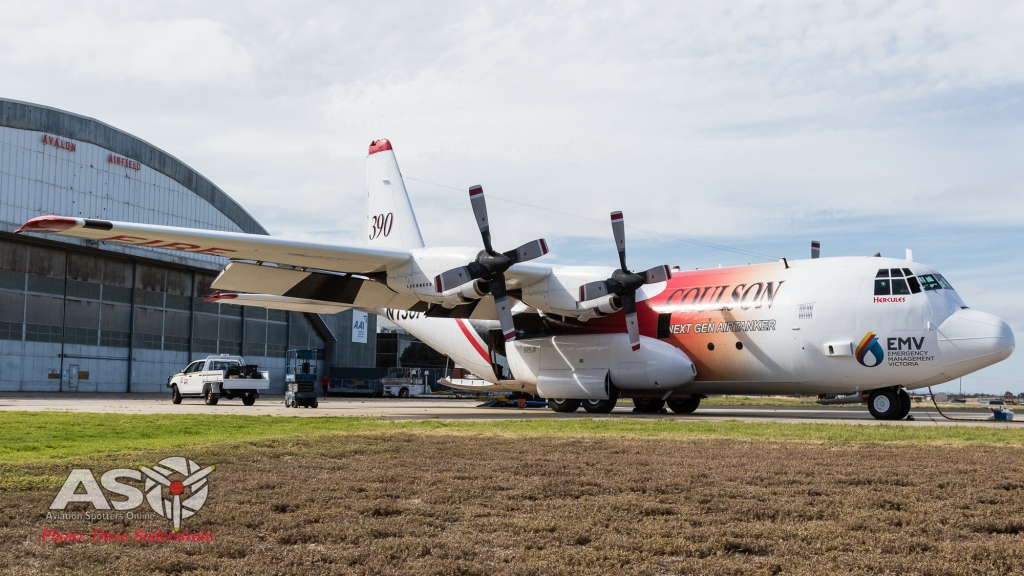
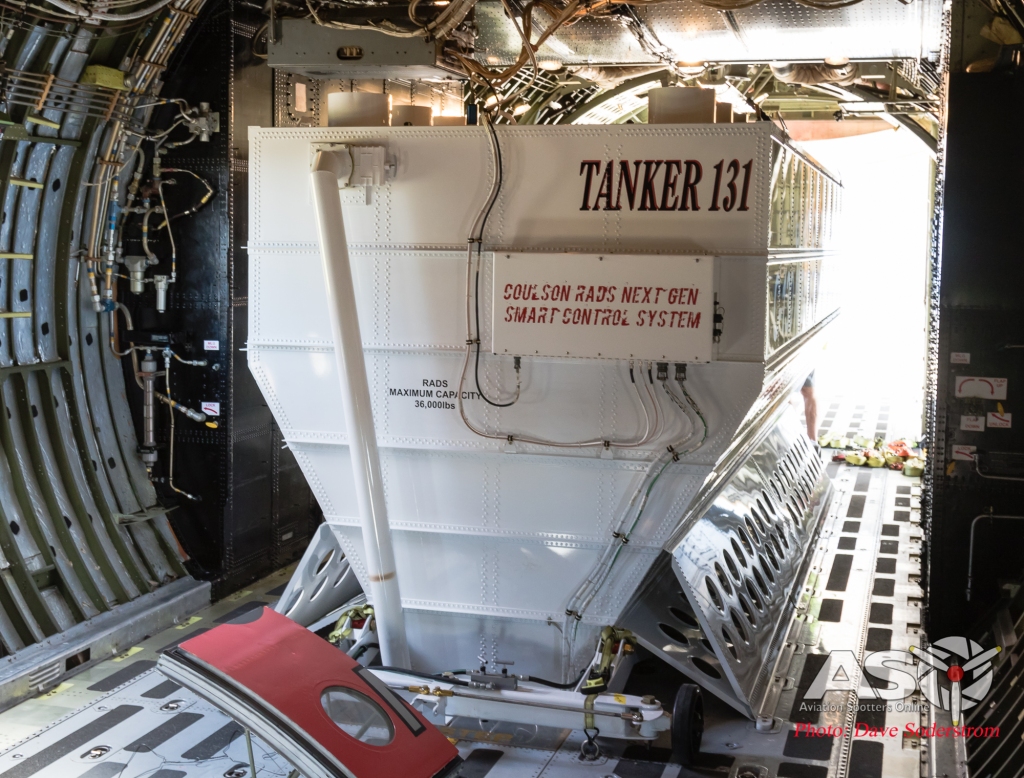

N130FF’s analogue flight deck.
C-130Q Overview:
- Type 1 Airtanker
- Primary role: Firebombing Other roles: Transport
- Two pilots and one flight engineer
- RADS-XXL constant flow firebombing system
- 15,450 litre retardant capacity
- Cruise speed (loaded) 545 km/h
- Typical cruise altitude (loaded) 12,500 feet
- Typical runway required 1,600m
- Max runway required (full load hot day) 1,950m
- 30.3m length, 40.4m wingspan
- 68,000 kg gross weight
- 4 x 4,500HP Allison T56-A-16 turbo prop engines
- Fuel consumption 2,650 litres/h of Jet-A1
- 2+ fire agency radios, Satellite tracking
Lockheed Martin L382-30
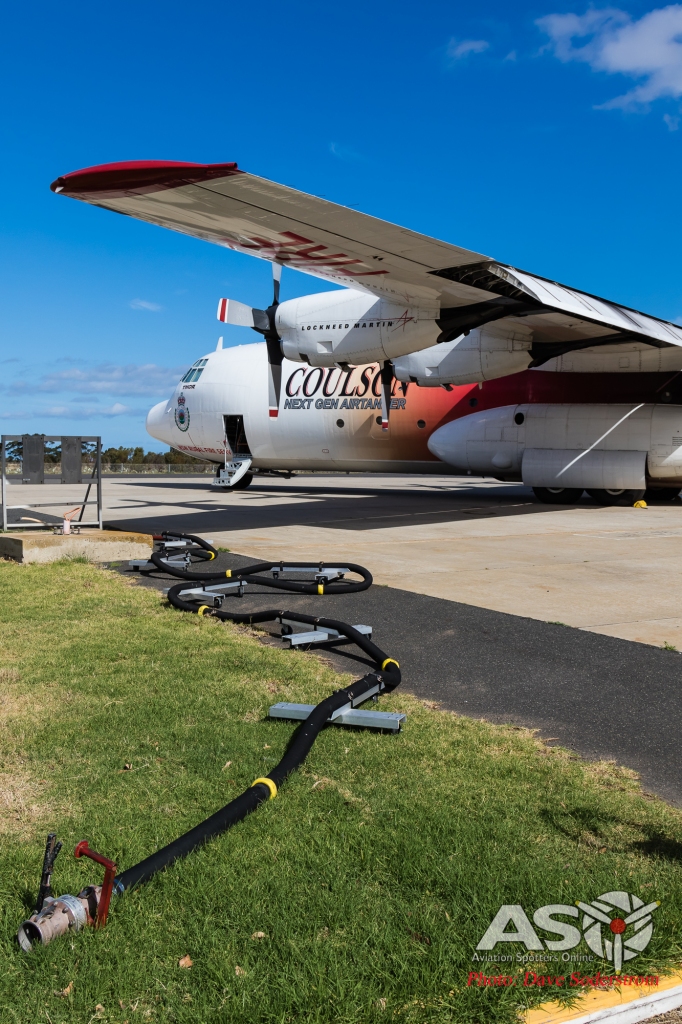
Water tank hoses on the ready.
L-382G which is the civilian versions of the military, Lockheed C-130H-30. Coulson was contracted by the NSWRFS to deploy this aircraft at RAAF Richmond on the outskirts of Sydney. N405LC ‘Bomber 132’ is designed and certified modification to the L100 to integrate a 4,300 US gallon firebombing system. This system is a derivative of the well regarded Aero Union RADS 1 firebombing tank. A 15,450 litre load of fire retardant solution can be carried on board the aircraft. The GPS linked computer controlled firebombing system delivers a constant flow of fire retardant or suppressant to the target area. The flexibility of the L100 design is a reason why it’s a successful fire fighting platform with a full retardant load on a 45 degree Celsius day the aircraft requires a 1,950m runway. Shorter runways can be utilized with a lighter load or on cooler temperature days. The aircraft is able to stay in communication with both air and ground support equipment, oil the fire ground thanks to its sophisticated communication and tracking equipment. Due to the nature of the large fires in California in the USA. EMV Victoria placed the L100 on contract until the C-130Q could arrive in country.
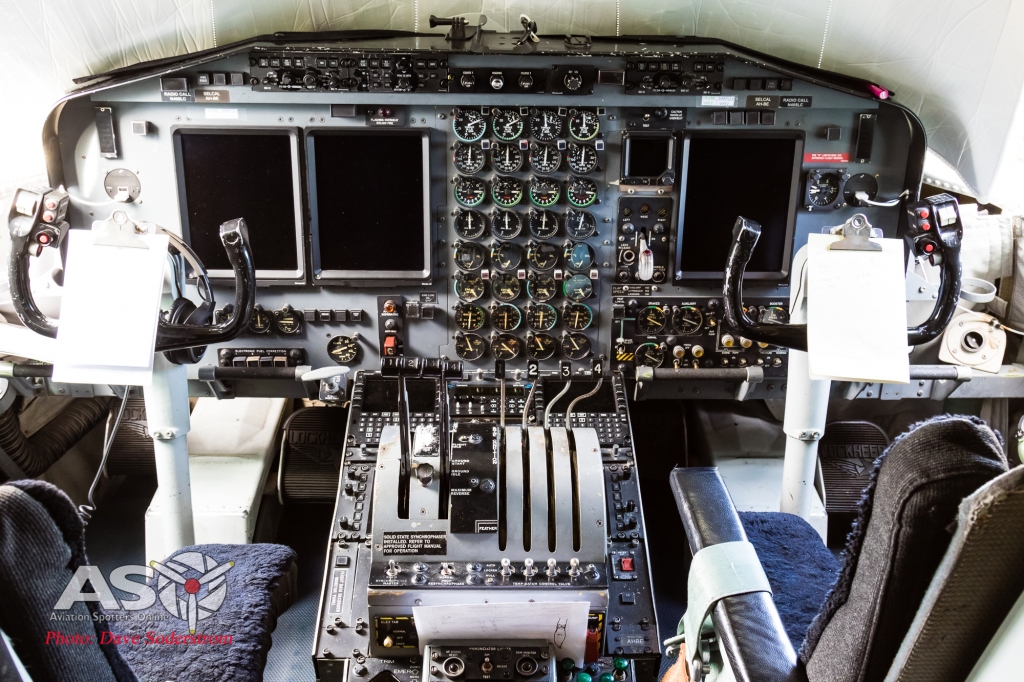
A noticeable difference between the two Hercules variants is the cockpit layouts. the L-382 has large digital displays, something the C-130Q is due to receive when it undergoes a refit.
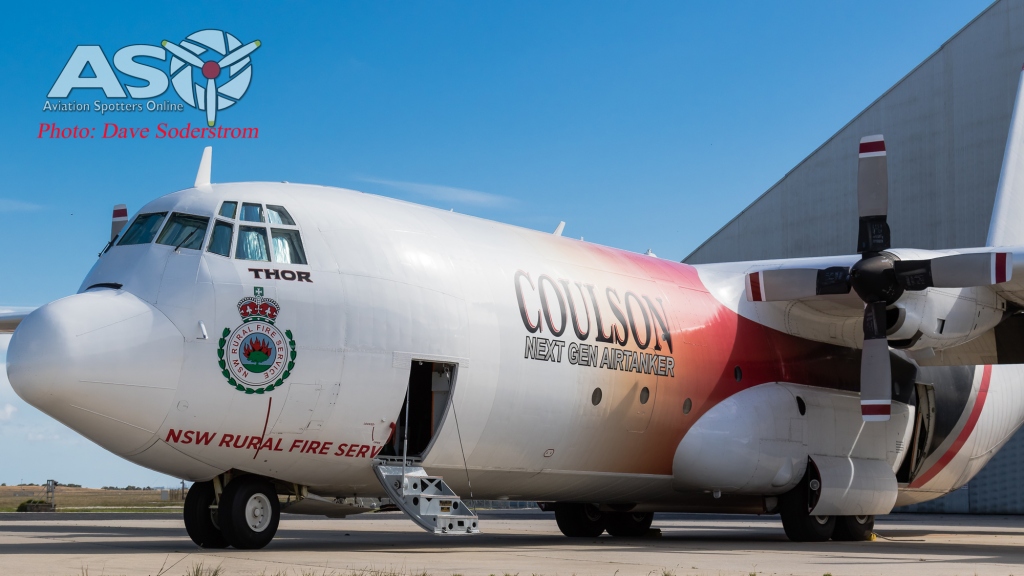
A New South Welshman in Victoria.
L100-30 Overview:
- Type 1 Airtanker
- Primary role: Firebombing
- Other roles: Transport
- Two pilots and one flight engineer
- RADS-XXL constant flow firebombing system 15,450 litre retardant capacity
- Cruise speed (loaded) 545 km/h Typical cruise altitude (loaded) 12,500 feet T
- Typical runway required 1,600m
- Max runway required (full load hot day) 1,950m 34.4m length,
- 40.4m wingspan
- 68,000 kg gross weight
- 4 x 4,500HP Allison 501‐D22A turbo prop engines
- Fuel consumption 2,650 litres/h of Jet-A1
- 2+ fire agency radios,
- Satellite tracking
Rotary Fleet Types
Sikorsky S-61
Coulson again were contracted to operate two S-61s in Victoria this season. Helitak 348 N161CG was based at Mansfield and Helitak 347, C-FIRX was based at Colac and took part in the night fire fighting trials.
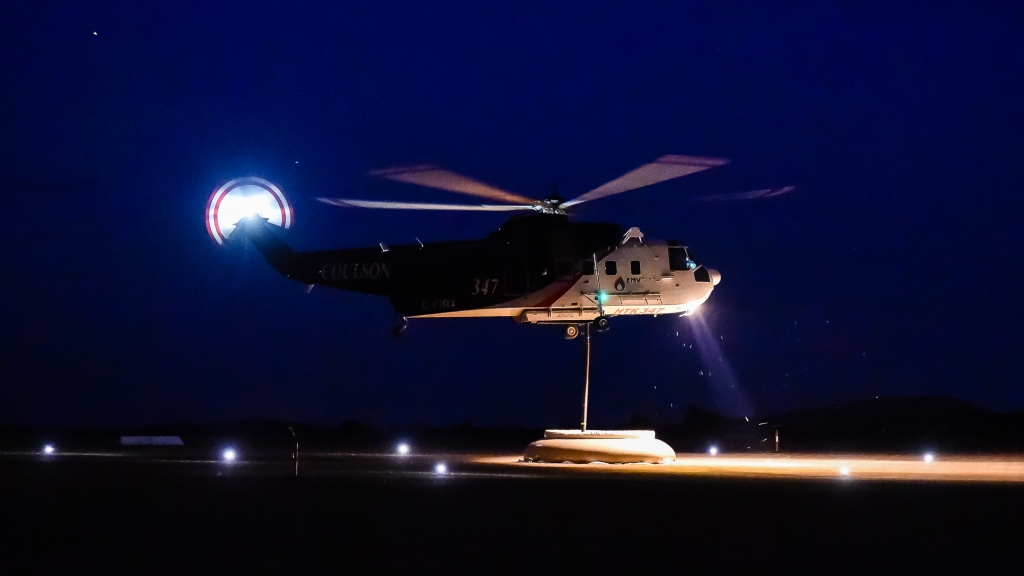
Helitak 347 conducts a night filling exercise as part of the tests for CASA approvals. (photo courtesy of EMV & Coulson)
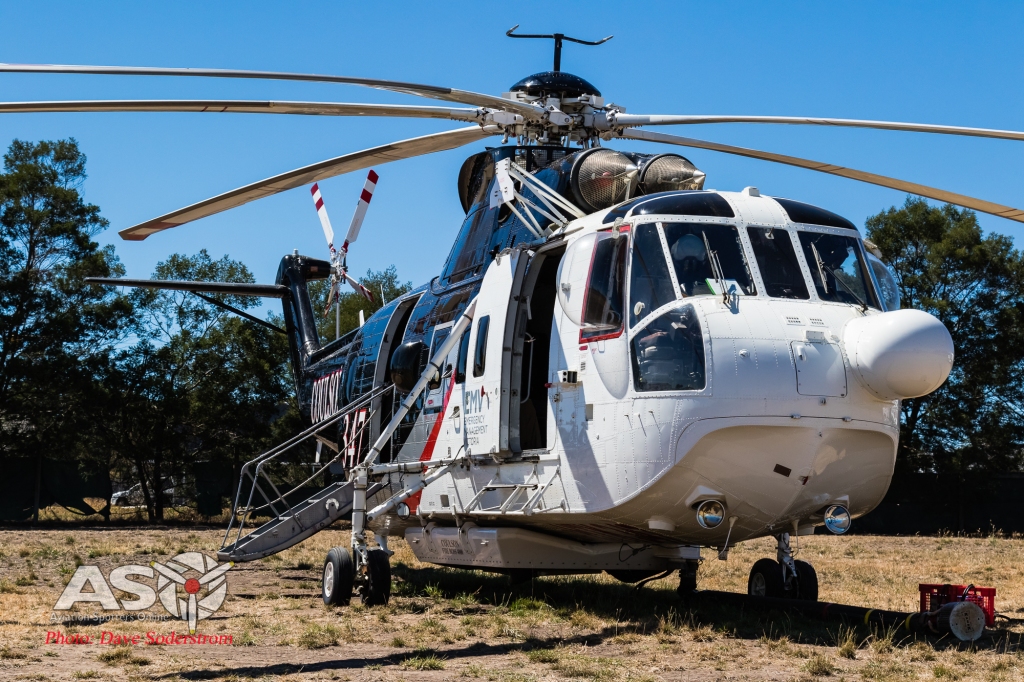
S-61N Overview:
- Call sign “Helitak”
- Primary roles: Firebombing, fire crew insertion
- Other roles: Transport, utility
- Twin engine helicopter
- Coulson single line rappel system
- Single pilot, up to eighteen passengers
- 4000 litre firebombing tank
- 9980 kg gross weight
- Cruise speed 225 km/h
- Five bladed main rotor
- 21.95m length, 18.9m rotor diameter
- 2 x 1500HP General Electric CT58-140 turbo shaft engines
- Fuel consumption 625 litres/h of Jet-A1
- 2+ fire agency radios
- Satellite tracking
Sikorsky S-64E Aircrane
For the fire season in Australia for 2017/18 Erickson-Kestrel put six S-64E Aircranes to work. Two in Victoria one each at Essendon, Helitak 341 ‘Gypsy Lady’ N189AC, Moorabbin Helitak 342 ‘Ichabod’ N957AC. Bankstown, New South Wales had Helitak 747 ‘Olga’ N6962R and Helitak 741 ‘Delilah’ N194AC (this airframe later located to Kestrel’s home base of Mangalore to operate in Victoria). The South Australia government deployed Helitak 734 “Elsie’ N218AC from Brukunga in the Adelaide Hills for operations in the Mount Lofty Ranges. In Western Australia Helitak 739 ‘Georgia Peach N154AC was deployed at Serpentine for its contract to the Western Australian Government.

The underside of N189AC, an Erickson S-64 which was fighting a fire in Sunbury Victoria.
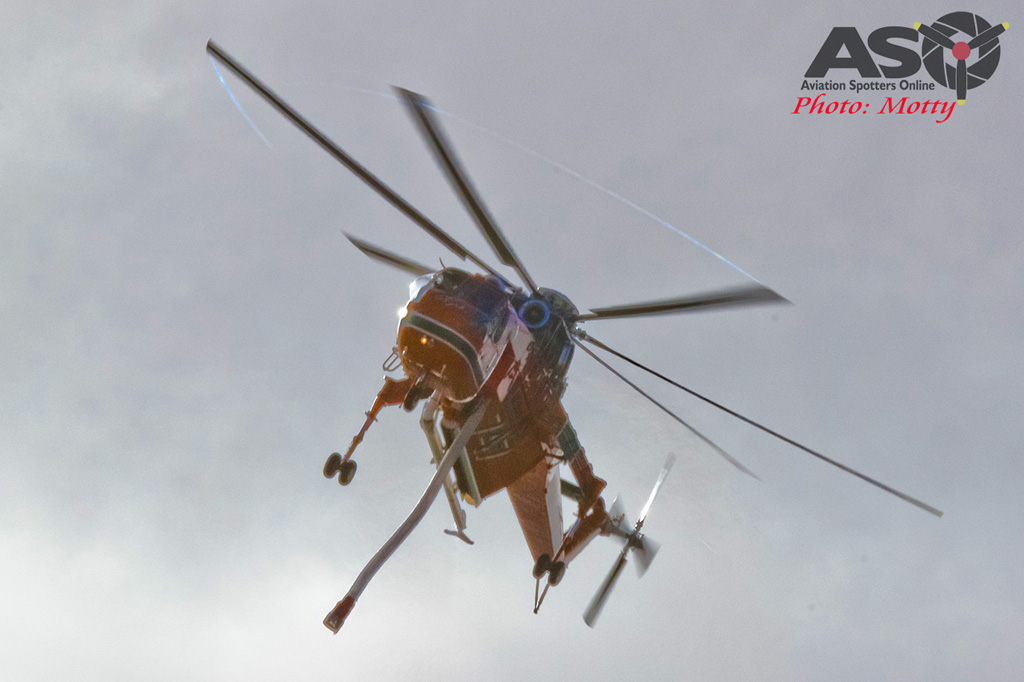

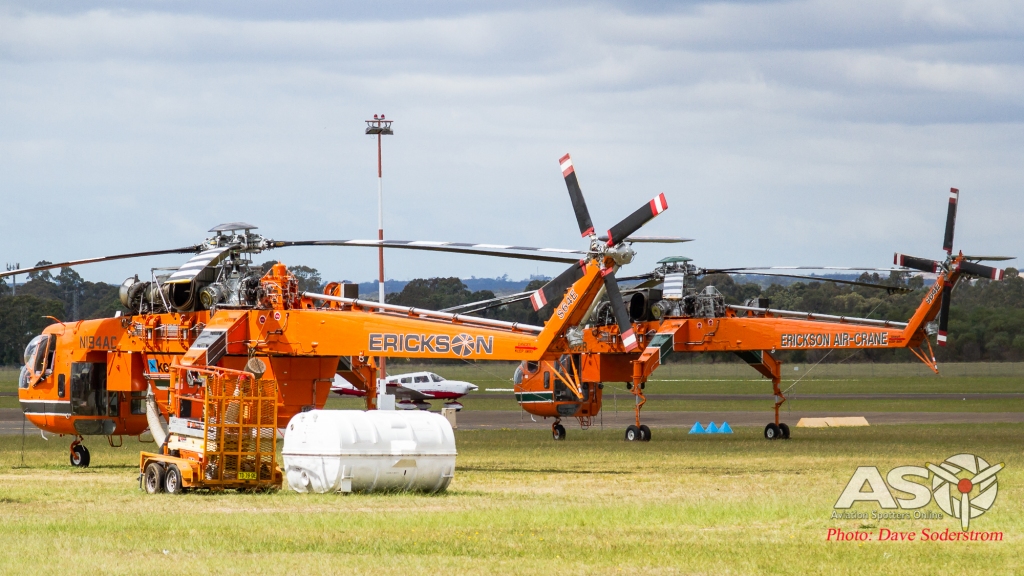
Two Erickson S-64E Skycranes were based at Bankstown in NSW this season.
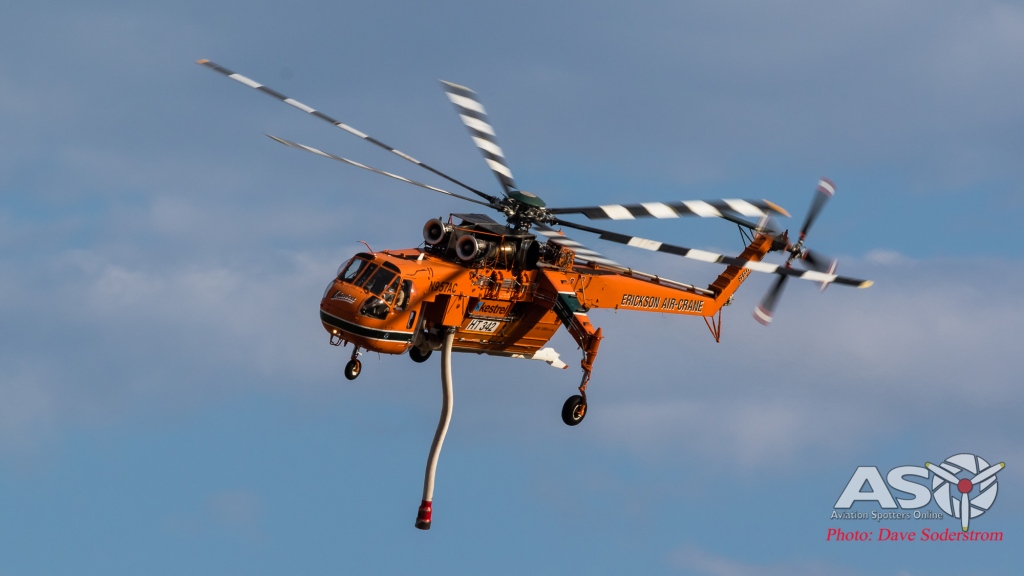

Helitak 344 located to Kestrel’s home base in Mangalore after finishing its contract in NSW.
S-64E Aircrane Overview:
- Call sign “Helitak”
- Primary role: Firebombing
- Other roles: Heavy lifting
- Twin engine heavy helicopter
- Two pilots for firebombing operations
- 7560 litre firebombing tank
- 7700 kg realistic external load
- 19090 kg gross weight
- Cruise speed 215 km/h
- Six bladed main rotor
- 26.8m length, 22.0m rotor diameter
- 2 x 4500HP Pratt & Whitney JFTD12A-4A turbo shaft engines
- Fuel consumption 1985 litres/h of Jet-A1
- 2+ fire agency radios
- Satellite tracking
Sikorsky S-76A
A single example of the Sikorsky S-76A is in use this season as part of the joint Night Fire Suppression Operations trial. Development of this capability will allow the undertaking of aerial fire fighting during the evening and into the night as well as potentially early in the morning. The trial is informing regulatory approvals required by the Civil Air Safety Authority (CASA) as well as identifying the systems of work that would underpin future operational use of the capability.

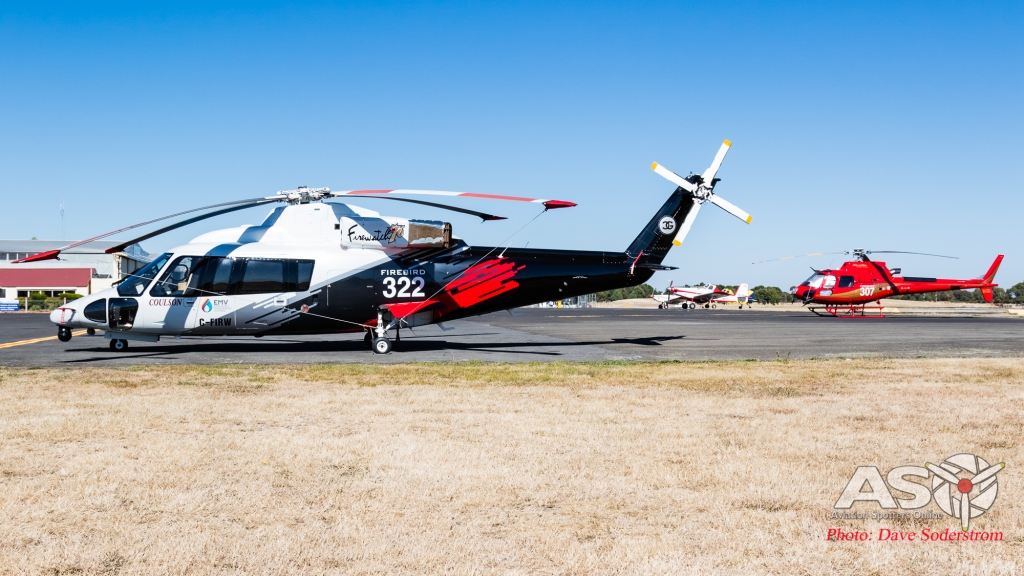
Sikorsky UH-60A Blackhawk
Pay’s Air Services again brought the converted ex US Army UH-60A Blackhawk to work in the country. Deployed from Pay’s Scone base in the New South Wales the aircraft was seen at work across New South Wales and Victoria. Operated in conjunction with Timberline Helicopters based at Sandpoint, Idaho in the USA, the helicopter N5630J in its extremely attractive blue and orange livery operated this season as Helitak 260. Earning the nickname ‘Thing 2’, the Blackhawk with its 3,400 Litre multi-shot Bambi Bucket, the aircraft was extremely valuable fighting fires across NSW. Eventually company owner Brian Jorgenson will have 6 of the UH-60s in this configuration and working. A the end of the season the Blackhawk went to work on a new ski lift in Victoria lifting the equipment into place.



UH-60A Blackhawk Overview:
- Call sign “Helitak”
- Primary roles: Fire crew insertion, Firebombing
- Crew: 2 pilots
- Capacity: 2,640 lb (1,200 kg) of cargo internally
- Length: 64 ft 10 in (19.76 m)
- Rotor diameter: 53 ft 8 in (16.36 m)
- Max. takeoff weight: 23,500 lb (10,660 kg)
- Powerplant: 2 × General Electric T700-GE-701C turboshaft, 1,890 hp (1,410 kW) each
- Twin engine helicopter
- 3400 litre firebombing bucket
Boeing CH-47D
Helimax Aviation’s Boeing CH-47D Chinook, N948CH started life as a United States Army CH-47C and was delivered as 74-22293. In 1990 it was upgraded to CH-47D standard. The Army sold the helicopter via auction in 2014. N948CH is one of 6 CH-47s currently in the fleet. For a detailed examination of the CH-47 please follow the link to our story: http://aviationspottersonline.com/when-the-chook-comes-to-town/

Helimax’s CH-47D N948CH Helitak 279 on standby at Wangaratta.
CH-47D Chinook Specifications
- Crew: 3
- Length: 98 ft 10 in (30.1 m)
- Rotor diameter: 60 ft per disk (18.3 m)
- Max takeoff weight: 50,000 lbs (22,680 kg)Maximum speed: 140 knots
- Cruise speed: 130 knots
- Range: 400 nm
- Endurance: 4 hrs
- Service ceiling: 18,500 ft
MBB/Kawasaki BK 117
Several examples of the BK-117 were on contract this season. Operated mainly on contract to the NSW RFS, the BK-117 is an extremely versatile machine.
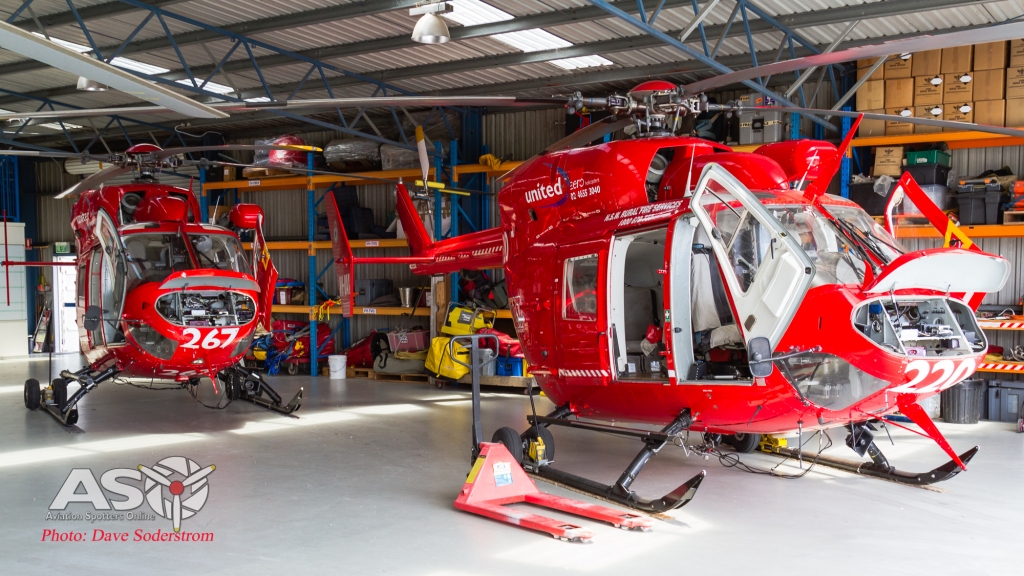
Two of United Helicopters BK-117s at their Camden base.

VH-VRP Kawasaki built BK117 B-1 or ‘Helitack 201’ is a 1990 build.
BK-117 Overview:
- Call sign “Helitak”
- Primary roles: Fire crew insertion, Firebombing
- Other roles: Transport,utility
- Twin engine helicopter
- 270kg 75m ‘Breeze Eastern’ HS-20200 rescue hoist
- Single pilot, up to eight passengers
- 900 litre firebombing bucket
- 3500kg gross weight
- Cruise speed 215 km/h
- Four bladed composite main rotor
- 13.0m length, 11.0m
- rotor diameter
- 2 x 750HPHoneywell LTS101-850B-2 turbo shaft engines
- Fuel consumption 300litres/h of Jet-A1
- 2+ fire agency radios, Satellite tracking
Bell 212

VH-NNN Helitak 331, a Bell 212 operated by Kestrel Helicopters sits on standby at the Shepparton Fire Base.
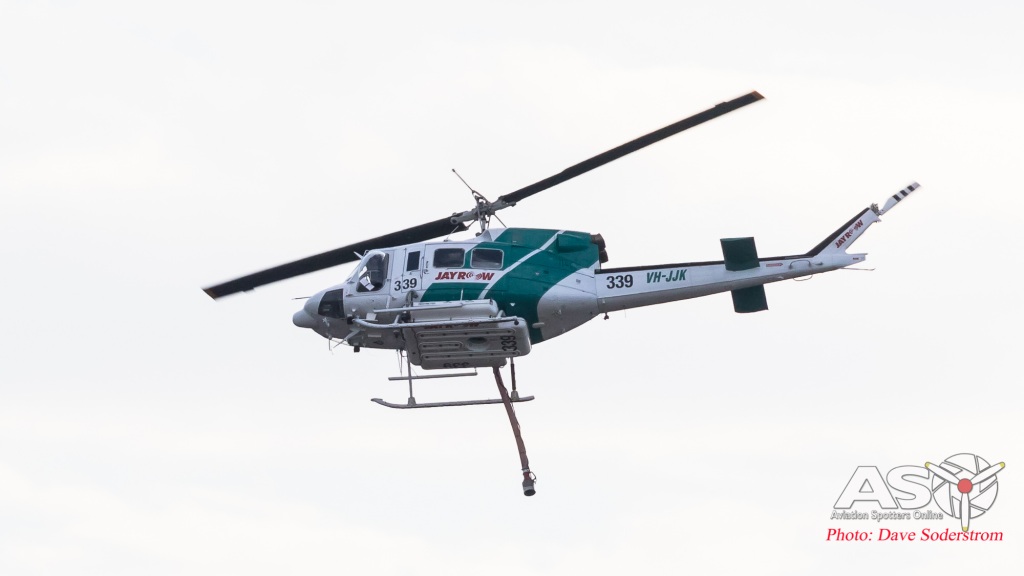
Jayrow Helicopters Bell 212, VH-JJK Helitak 339 working on the Mt Cottrel Fire.
Bell 212 Overview:
- Call sign “Helitak”
- Primary roles: Firebombing, fire crew insertion
- Other roles: Transport, utility
- Twin engine helicopter
- Two line rappel system
- Single pilot, up to fourteen passengers
- 1477 litre firebombing tank
- 5090 kg gross weight
- Cruise speed 185 km/h
- Two bladed main rotor
- 17.4m length, 14.6m rotor diameter
- 1800HP Pratt and Whitney PT6T-3BFTwin-Pac engine
- Fuel consumption 340 litres/h of Jet-A1
- 2+ fire agency radios
- Satellite tracking
Bell 214B Big Lifter

McDermott Helicopters Bell 214B Big-Lifter VH-SUM flying as Helitak 335 out of Bendigo Fire base.
C-FXNI / Hwlitak 677, Bell 214B-1 Big Lifter of McDermott Aviation (leased from East West Helicopters, Salmon Arm, BC, Canada) Image by Brenden Scott
McDermott Helicopters Bell 214B Big-Lifter N254SM Helitak 673. Image by Brenden Scott.
Bell 214 Overview:
- Call sign “Helitak”
- Primary role: Firebombing
- Other roles: passenger / cargo transport
- Single engine helicopter
- Single pilot, up to 14passengers
- 2650 litre firebombing tank capacity
- Cruise speed 240 km/h
- Two bladed main and tail rotors
- 6300kg maximum take-off weight
- 17.7m length, 14.7 rotor diameter
- 2950HP Lycoming T55-08D
- turbo shaft engine,
- Fuel consumption
- 600 litres/h ofJet-A1
- 2+ fire agency radios
- satellite tracking
Bell 412
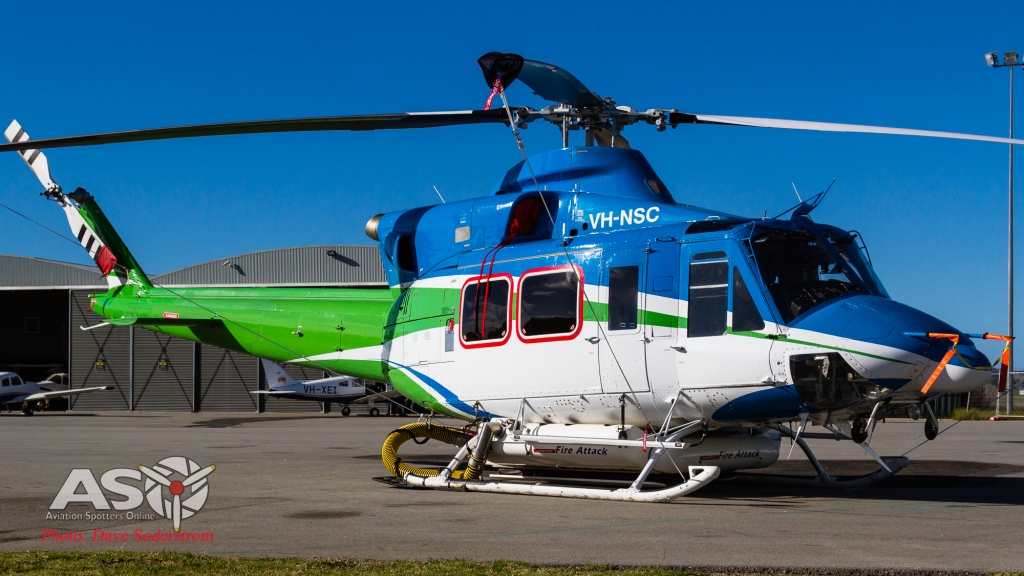
A new comer to the fire fighting world is this airframe. Originally operated for the Snowy Hydro SouthCare Aeromedical Service by CHC Helicopters. It is now part of the Canberra Helicopters group and has been fitted out for the fire fighting attack role. Noted here at Wagga Wagga in NSW.
In early 2018, Kestrel conducted night firebombing capability development trials and in early March 2018 integrated its Operational Test and Evaluation Phase into the Night Firebombing Trials coordinated by Emergency Management Victoria. Kestrel is the first operator in Australia to conduct live fire suppression at night from a Bell 412 Helitak and has attained unrestricted approval to conduct night aerial firebombing from the Civil Aviation Safety Authority.

VH-KHU is one of two ex Japanese, Tokyo Metropolitan Police airframes operated by Kestrel Aviation. Seen here at its home base at Managlore in Victoria. KHU represents one of two recently NVIS (Night Vision Imaging System) modified aircraft in the Kestrel fleet.

VH-KHU is seen involved in the Night Fire Fighting trials earlier this year. (Image from Kestrel Aviation)

VH-KAC part of the Kestrel Aviation group was on standby at Ballarat for some of the season.
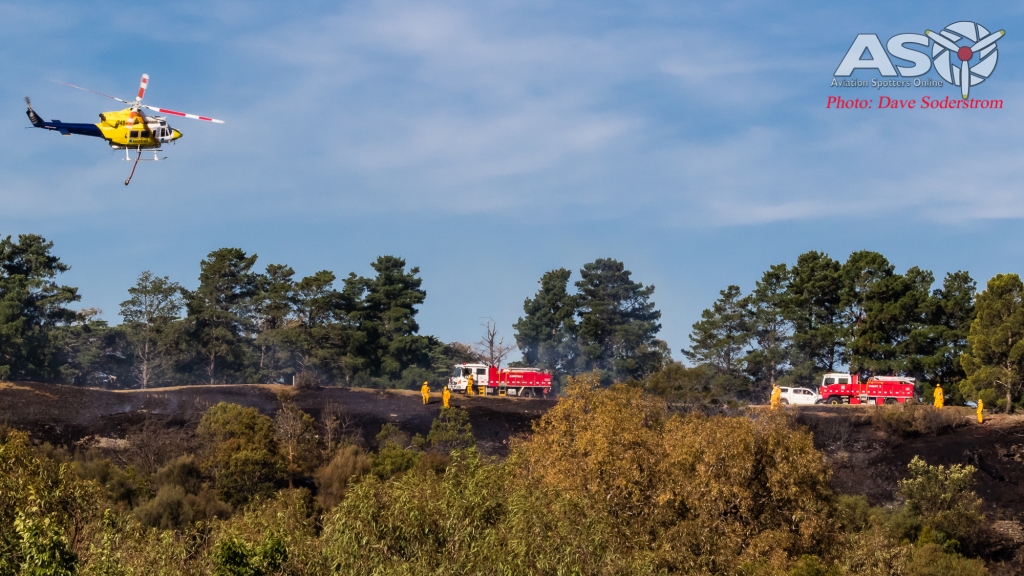
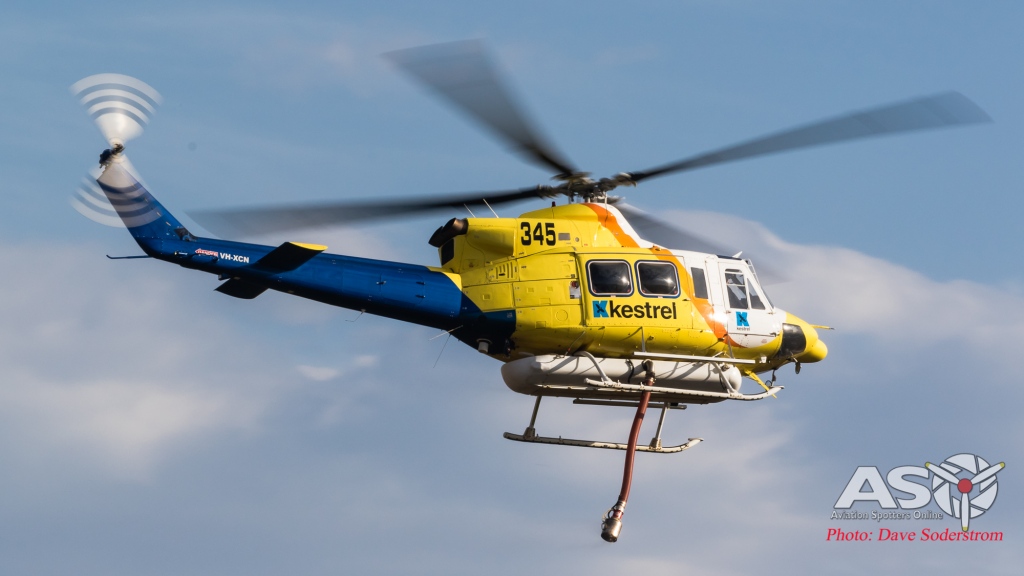
VH-XCN part of the large Kestrel Aviation fleet, is a new comer to the fire bombing role having previously operating for Lifeflight in the aeromediacal role. the aircraft was fitted with a Conair 85-KE firefighting belly tank, among other equipment.
Bell 412 Overview:
- Call sign “Helitak”
- Primary roles: Firebombing, fire crew insertion
- Other roles: Transport, utility
- Twin engine helicopter
- 270kg, 75m ‘Goodrich’ winch or two line rappel system
- Single pilot, up to eleven passengers
- 1400 litre firebombing tank
- 5400 kg gross weight
- Cruise speed 225 km/h
- Four bladed main rotor
- 17.1m length, 14.0m rotor diameter
- 1800HP Pratt and Whitney PT6T-3BF Twin-Pac engine
- Fuel consumption 410 litres/h of Jet-A1
- 2+ fire agency radios
- Satellite tracking
Bell 204/UH-1 Overview

Pay’s UH-1E operating as Helitak 221.

Part of the Touchdown Helicopters fleet based in the Illawarra VH-OXT is a UH-1H.
- Call sign “Helitak”
- Primary roles: Firebombing
- Other roles: Transport, utility
- Single engine helicopter
- Single pilot, up to eleven passengers
- 1290 litre long-line firebombing bucket
- 4300 kg gross weight
- Cruise speed 185 km/h
- Two bladed main rotor 17.3m length
- 14.6m rotor diameter
- 1400HP Pratt and Whitney T53-13B turbo shaft engine
- Fuel consumption 340 litres/h of Jet-A1
- 2+ fire agency radios
- Satellite tracking
Bell 206L-3 LongRanger Overview:

Aerial Agriculture’s Jetranger VH-ONR, flying as Firebird 233
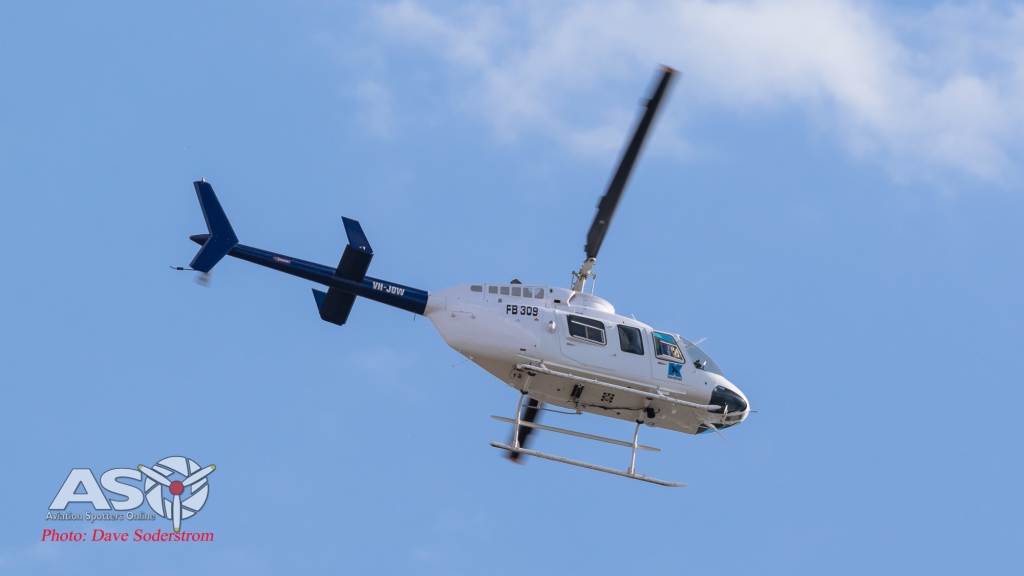
Kestrel Helicopters Bell 206, VH-JOW flying as Firebird 309.

Heli Surveys, Bell 206B VH-BHF, flies as Firebird 298.

North Australia Helicopters, Bell 206 Longranger VH-XXJ.
- Call sign “Firebird”
- Primary role: air attack supervision
- Other roles: reconnaissance / utility
- Single engine helicopter
- Single pilot, six passengers
- 1800 kg gross weight
- Cruise speed 220 km/h
- Two bladed main and tail rotors
- 13.0 m length, 11.3 rotor diameter
- Rolls Royce / Allison C30P Turbo shaft engine
- Fuel consumption 140 litres/h of Jet-A1
- 650 HP available at take off
- 2+ fire agency radios
- Satellite tracking
AS350B3 Squirrel Overview:

VH-ZHG is operated by EPS helicopters and is seen with its long line deployed operating as Park Air 3.

VH-PHU is a an AS530 BA operated by Professional Helicopters as Firebird 323 and was seen here at Mangalore this season.

AS350 B2 Firebird 310 VH-LEY is owned by Forest Air and was part of the fleet based at Colac in Victoria.
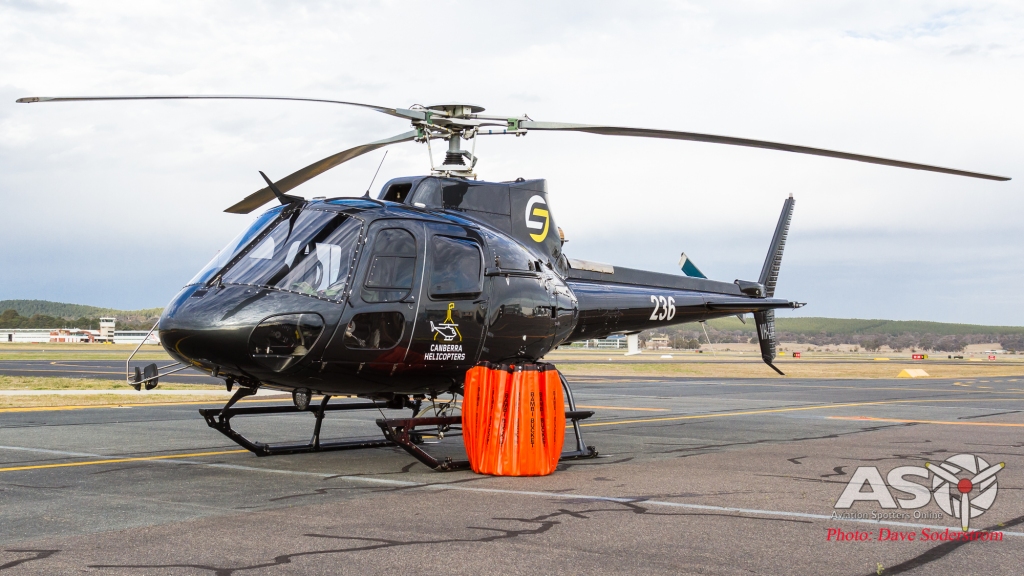
Canberra Helicopters VH-LVM an AS.350.B2, at rest in Canberra displays its sling load bucket it uses for its fire deployments.
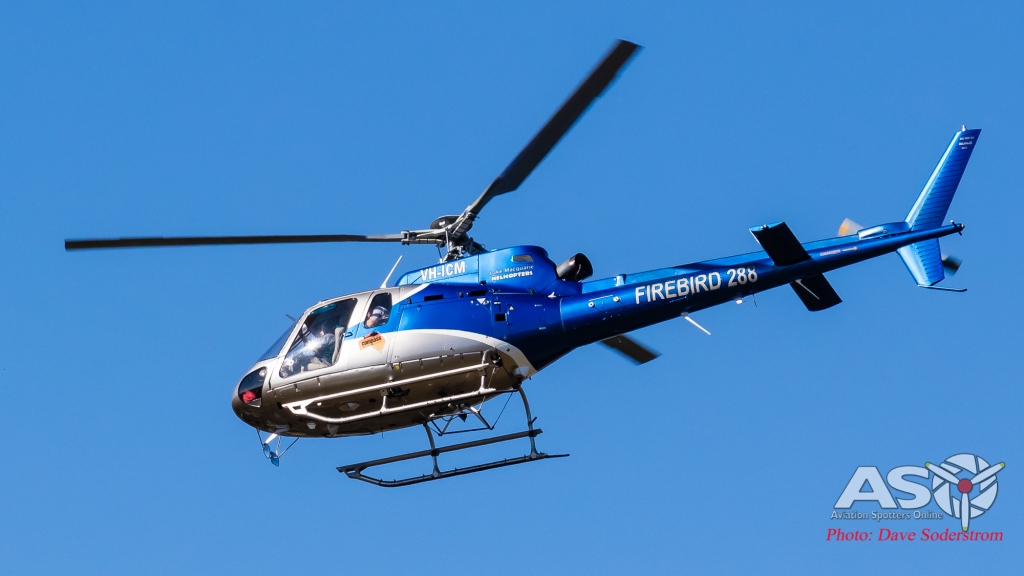
VH-ICM and AS350 B2 operated by Lake Macqurie Helicopters flies as Firebird 288.
AS350B3 Squirrel Overview:
- Call sign “Firebird”
- Primary roles: Firebombing, supervision, winching
- Other roles: Reconnaissance, utility
- Single engine helicopter
- Single pilot, up to five passengers
- 1100 litre firebombing tank or bucket
- 2800 kg gross weight
- Cruise speed 200 km/h
- Three bladed composite main rotor
- 12.9m length, 10.7m rotor diameter
- Turbomeca Arriel 2D turbo shaft engine 847 HP available at take off
- Fuel consumption 160 litres/h of Jet-A1
- 2+ fire agency radios
- Satellite tracking
Eurocopter AS355F1 Twin Squirrel

VH-ELP owned by Rotorlift in Tasmania operates Firebird 705, which is outfitted for sling load bucket operations.
- Call sign “Firebird”
- Primary roles:Supervision, firebombing
- Other roles: Reconnaissance,utility
- Twin engine helicopter
- Single pilot, up to five passengers
- 680 litre firebombing tank or bucket
- 2400 kg gross weight
- Cruise speed 230km/h
- Three bladed composite main rotor
- 12.9m length, 10.9m rotor diameter
- 2x Rolls Royce Allison 250-C20Fturbo shaft engines
- 840HP available at take off
- Fuel consumption 220litres/h of Jet-A1
- 2+ fire agency radios, Satellite tracking
Airbus Helicopters AS365 Dauphin
The Dauphin is a unique helicopter in the fire fighting fleet. It has several attributes which make it highly useful in an emergency situation, with its high transit speed, large cabin for passengers, and powerful engines for lifting its an extremely adaptable type. The ability to winch fire crews into areas also is another useful capability. McDermott Aviation operates several of the type and these have been seen in New South Wales and Queensland.
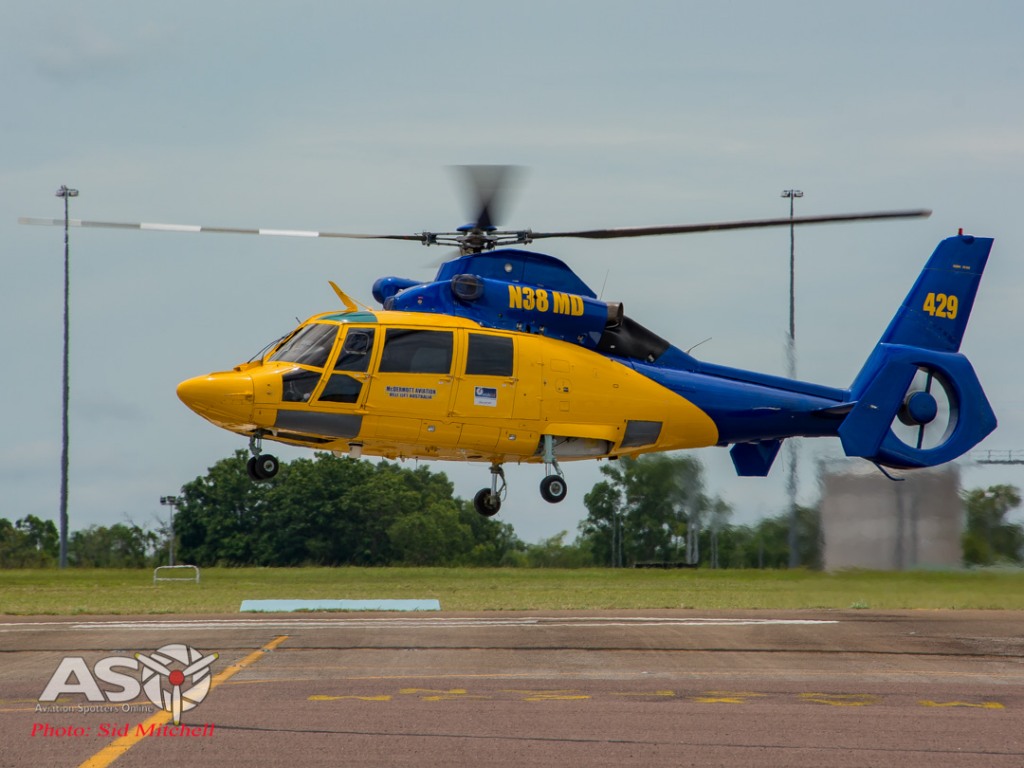
McDermott Aviation/Helilift Airbus Helicopter AS365 N3 Dauphin, N38MD operated as Helitak 429 when on contract.
Airbus Helicopters AS365 Overview:
- Call sign “Helitak”
- Primary roles: Fire crew insertion, Firebombing Other roles: Transport, utility
- Twin engine helicopter 270kg 100m ‘Air Equipment’ Winch
- Single pilot, up to eight passengers
- 1025 litre firebombing bucket
- 4250 kg gross weight
- Cruise speed 260 km/h
- Four bladed composite main rotor
- 13.7m length, 11.9m rotor diameter
- 2 x 750HP Arriel 1C2 turbo shaft engines
- Fuel consumption 340 litres/h of Jet-A1
- 2+ fire agency radios
- Satellite tracking
MBB Bo-105LS
In 1984, the Bo-105LS was developed with the enlarged fuselage of the Bo 105CBS combined with more powerful Allison 250-C28C engines to increase the maximum take-off weight as well as hot-and-high flight performance; the Bo-105 LS was manufactured under a cooperative arrangement with Eurocopter Canada.
VH-XRG, FIREBIRD 625 Eurocopter Bo-105LS-A3 of Heliwest
MBB Bo-105LS Overview:
- Call sign “Helitak”
- Primary roles: Fire crew insertion, Firebombing Other roles: Transport, utility
- Crew: 1 or 2 pilots
- Capacity: 4
- Max. takeoff weight: 2,500 kg (5,511 lb)
- Powerplant: 2 × Allison 250-C20B turboshaft engines, 313 kW (420 shp) each
- Cruise speed: 204 km/h (110 knots, 127 mph)
Aviation Spotters Online, wishes to thank all the pilots, crew and companies who have taken the time to work with us on this article. It is dedicated to all the fire Fighting personal, both paid and volunteer who go above and beyond to protect Australian’s from fire. Fly safe and see you for the next overview.
Dave

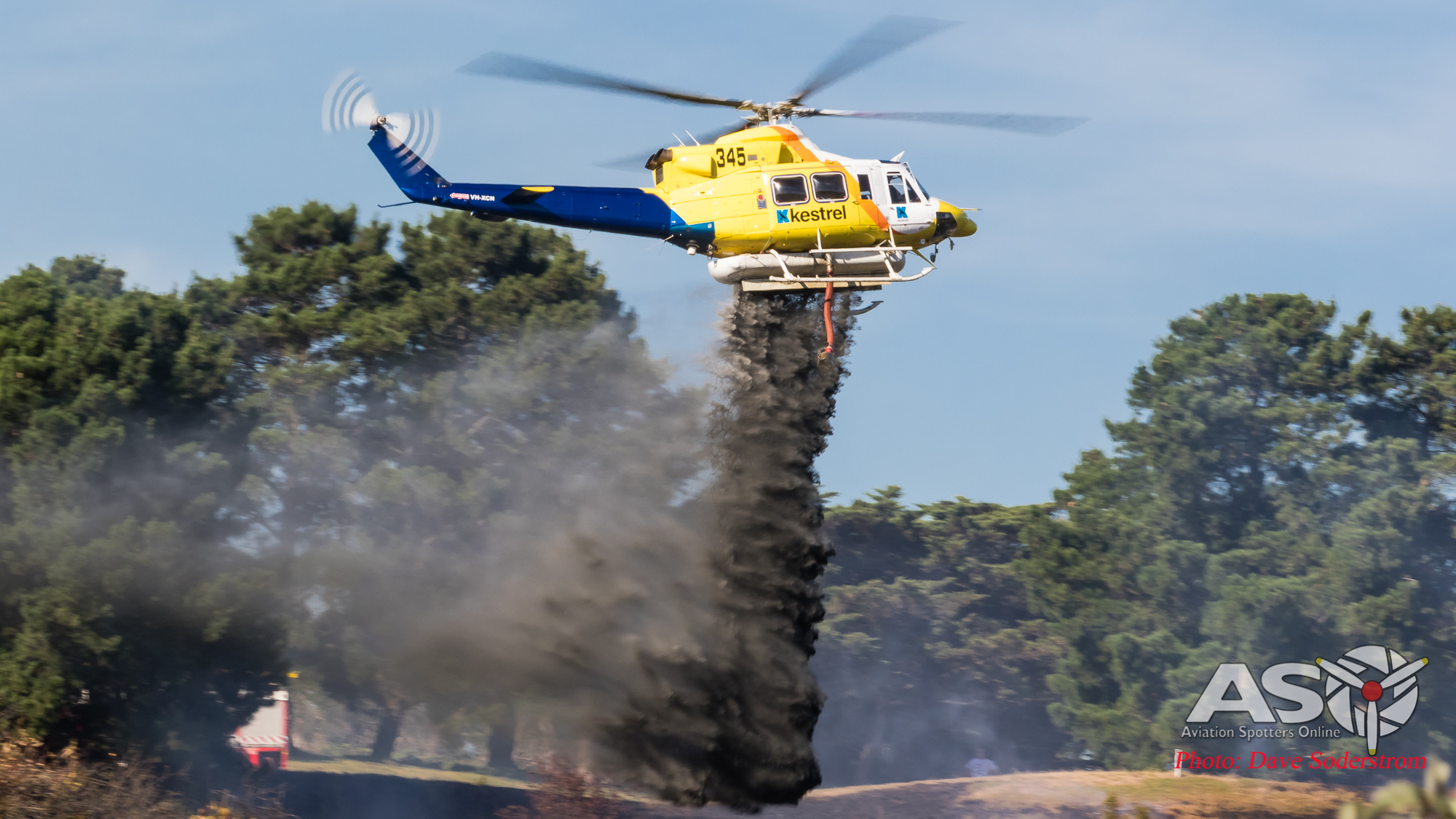
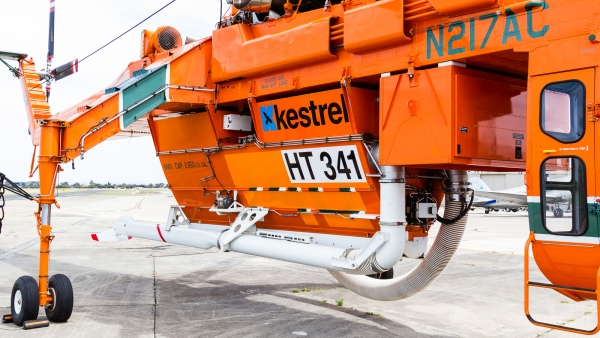







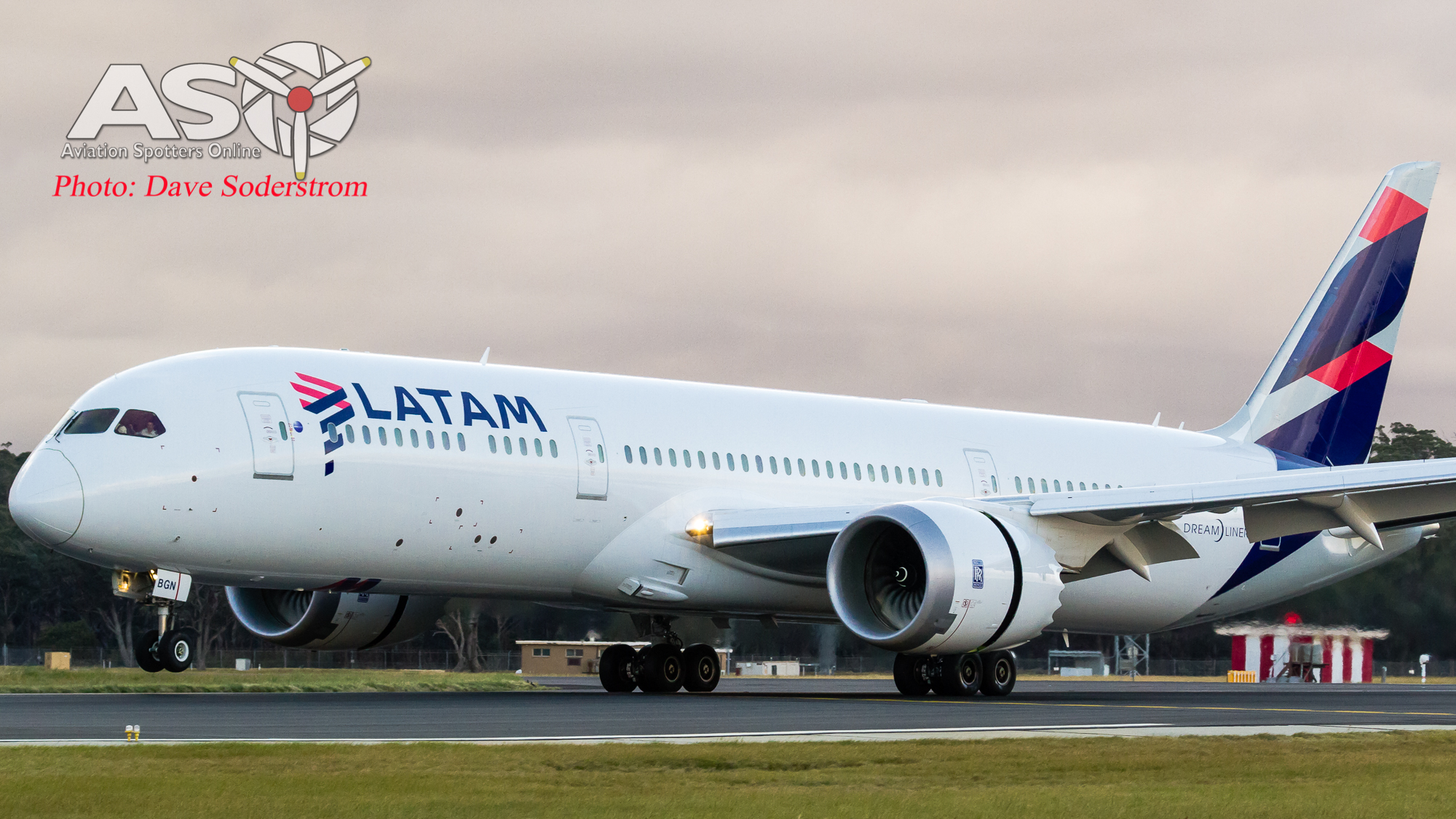
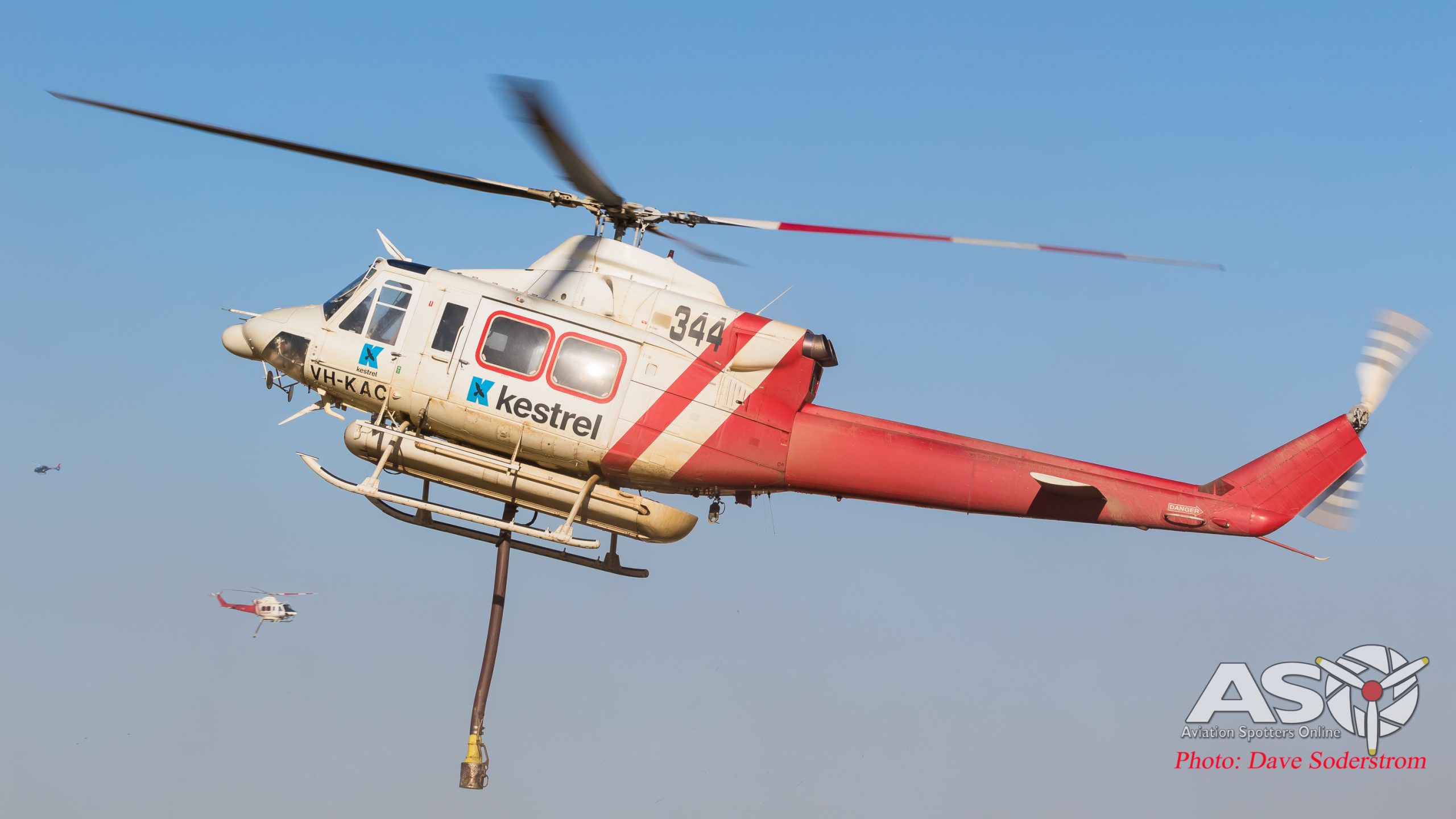
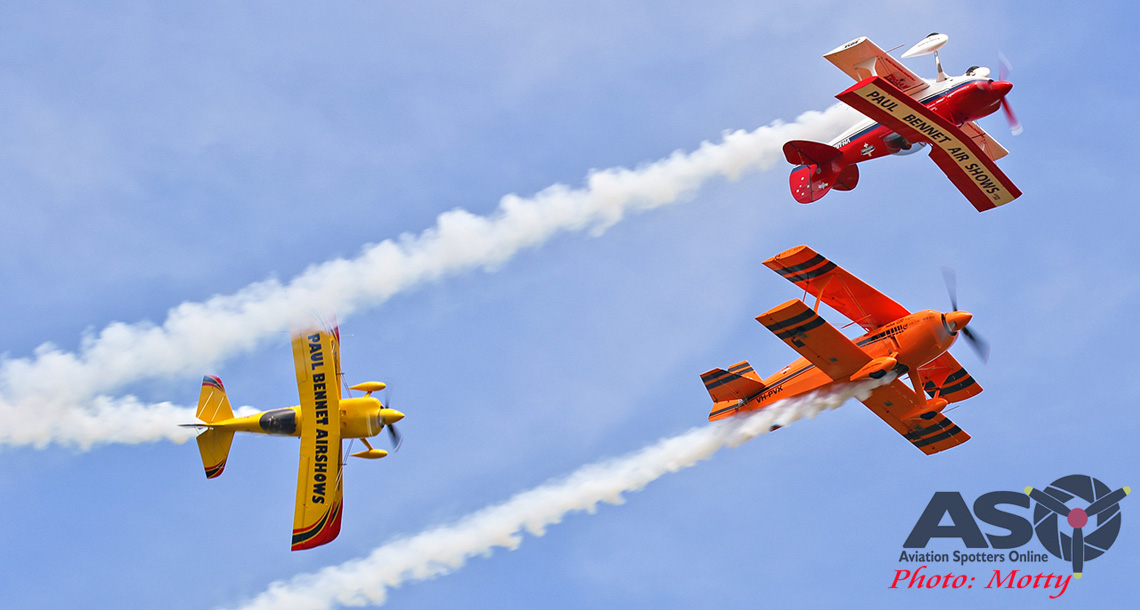





Some great photos Dave, in particular the night shots, well done mate.
I have just returned from the UK, serving abroad as an aircraft engineer and I’m looking into service in Australia as an aircraft engineer and I have red this article on Australian firebombing from end to end, I was very impressed with the night bombing trials and the approval by CASA. I was so impressed, I will be looking into a career in this field that will carry me up to retirement….! Very very interesting….
Andrew, wow thanks for the kind works. Im glad my words have have a impact on you and your future career path. Good luck, Dave
hi Dave…i am writing a children’s book about firefighting pilots.. i would love your input…
all the pilots ive interviewed are from Europe and Brazil…im donating the book ti the Queensland children’s hospital..
can you help me with stories and photos…
that would lovely…
talk to you soon…leese….
..
great shots and a great reference to us who know very little about aviation..I love the facts and history of the aircraft…It helps spotting them this (2019) fire season
Thanks Fred, for the message. I’m already working on this years round up. Lots of new aircraft to talk about and lots of pictures too. So keep an eye out for the 2018/19 coverage soon.